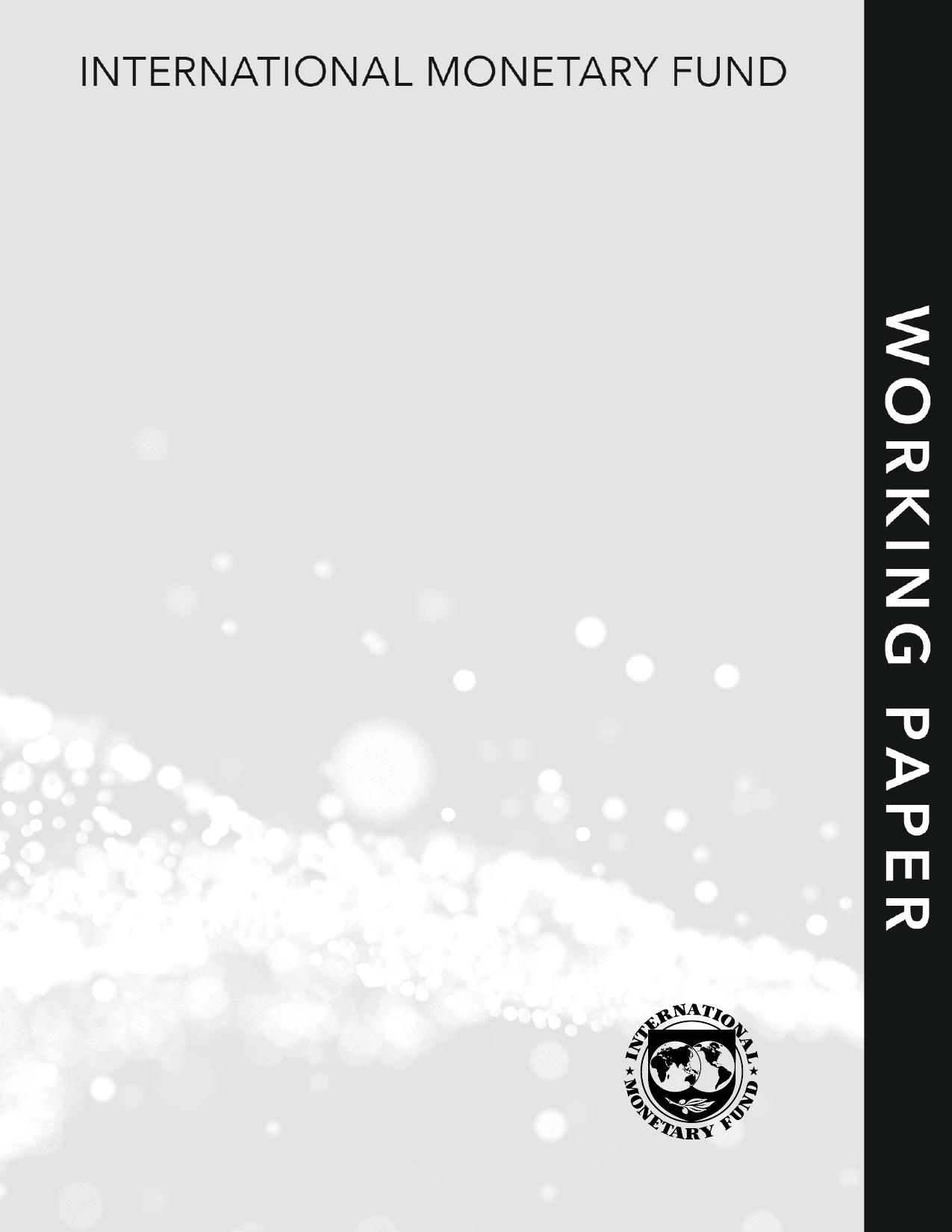DefaultRiskandTransitionDynamicswithCarbonShocksSujanLamichhaneWP/23/174IMFWorkingPapersdescriberesearchinprogressbytheauthor(s)andarepublishedtoelicitcommentsandtoencouragedebate.TheviewsexpressedinIMFWorkingPapersarethoseoftheauthor(s)anddonotnecessarilyrepresenttheviewsoftheIMF,itsExecutiveBoard,orIMFmanagement.2023AUG©2023InternationalMonetaryFundWP/23/174IMFWorkingPaperMonetaryandCapitalMarketsDepartmentDefaultRiskandTransitionDynamicswithCarbonShocksPreparedbySujanLamichhaneAuthorizedfordistributionbyHirokoOuraAugust2023IMFWorkingPapersdescriberesearchinprogressbytheauthor(s)andarepublishedtoelicitcommentsandtoencouragedebate.TheviewsexpressedinIMFWorkingPapersarethoseoftheauthor(s)anddonotnecessarilyrepresenttheviewsoftheIMF,itsExecutiveBoard,orIMFmanagement.ABSTRACT:Climatemitigationpoliciesarebeingintroducedaroundtheworldtolimitglobalwarming,generatingnewriskstotheeconomy.Thispaperdevelopsacontinuoustimeheterogeneousagentsmodeltostudytheimpactofcarbonpricingpolicyshocksoncorporatedefaultriskandtheconsequenttransitiondynamics.Wederiveaclosed-formsolutiontocorporatedefaultprobabilitybasedonfirms'intertemporaloptimizationdecisionsandexplicitlycharacterizethetransitionspeed.Thisallowsforstudyingpolicyimplicationsinananalyticallytractableway.ThemodeliscalibratedtodifferentUScorporatesectorstoquantifytheheterogeneouseffectsofcarbonpriceshocks.Whilecarbon-intensivesectorsfaceincreaseddefaultrisks,therearenotableasymmetriceffectswithinsectors.Highercarbonpricesincreasedefaultriskbutalsoinducefastertransitiontowardsthenewpost-shocksteadystatewithahighlynon-linearimpact.Ourresultssuggestthatoncearangeofpossiblepriceshocksareaccountedfor,theincreaseinthecostofcapital/riskpremiumsmightbesharplydifferentacrosssectors.RECOMMENDEDCITATION:Lamichhane,S.2023.“DefaultRiskandTransitionDynamicswithCarbonShocks.”IMFWorkingPaper2023174,MonetaryFund,Washington,DC.JELClassificationNumbers:G32,G12,E44,Q58Keywords:Defaultrisk;climaterisk;carbonprice;transitiondynamics;costofcapital;riskpremium.Author’sEmailAddress:SLamichhane@imf.orgWORKINGPAPERSDefaultRiskandTransitionDynamicswithCarbonShocksPreparedbySujanLamichhaneDefaultRiskandTransitionDynamicswithCarbonShocks∗SujanLamichhane†ThisVersion:June2023AbstractClimatemitigationpoliciesarebeingintroducedaroundtheworldtolimitglobalwarming,generatingnewriskstotheeconomy.Thispaperdevelopsacontinuoustimeheterogeneousagentsmodeltostudytheimpactofcarbonpricingpolicyshocksoncor-poratedefaultriskandtheconsequenttransitiondynamics.Wederiveaclosed-formsolutiontocorporatedefaultprobabilitybasedonfirms’intertemporaloptimizationde-cisionsandexplicitlycharacterizethetransitionspeed.Thisallowsforstudyingpolicyimplicationsinananalyticallytractableway.ThemodeliscalibratedtodifferentUScorporatesectorstoquantifytheheterogeneouseffectsofcarbonpriceshocks.Whilecarbon-intensivesectorsfaceincreaseddefaultrisks,therearenotableasymmetricef-fectswithinsectors.Highercarbonpricesincreasedefaultriskbutalsoinducefastertransitiontowardsthenewpost-shocksteadystatewithahighlynon-linearimpact.Ourresultssuggestthatoncearangeofpossiblepriceshocksareaccountedfor,theincreaseinthecostofcapital/riskpremiumsmightbesharplydifferentacrosssectors.Keywords:Defaultrisk,climaterisk,carbonprice,transitiondynamics,costofcapital,riskpremium.JELCodes:G32,G12,E44,Q58∗IwouldliketothankRobertJarrow,PierpaoloGrippa,HirokoOura,andseminarparticipantsatIMFandJHUCareyfortheirhelpfulcommentsanddiscussions.†InternationalMonetaryFund,email:slamichhane@imf.org.Theviewsexpressedinthispaperarethoseoftheauthor(s)anddonotnecessarilyrepresenttheviewsoftheIMF,itsExecutiveBoard,orIMFmanagement.1IntroductionClimate-relatedpoliciesarebeingconsideredaroundtheworldtolimittheimpactofclimatechangeonhumansociety.Nearly200countriessignedtheParisAgreementin2015,pledgingtolimittheglobalwarmingincreasetowellbelow2◦Ccomparedtopre-industriallevels.Achievingthisgoalrequiresthesubstantialreductioningreenhousegas(GHG)emissionsandtheglobaltransitiontoalow-carboneconomy.However,thereisuncertaintyregardinghowtheseclimate-relatedpolicieswillbeimplemented,therebygeneratingnewriskstotheeconomy.1Oneofthemainstrategiesproposedforlimitingemissionsistointroducecarbonpricingpolicies(HLCCP2017).Carbonpriceshockscouldleadtoapotentiallysharpincreaseincorporatedefaultrisks.Inthisregard,understandingtheheterogeneousandasymmetriceffectsofcarbonshocksacrossandwithinvarioussectorsoftheeconomybecomescrucialfromafinancialandeconomicstabilityperspective.Anothercriticalaspectforpolicymak-ersistounderstandhowfastdifferentsectorsmighttransitiontothenewsteadystateofheighteneddefaultrisksafterthecarbonpriceshocksandtherelationbetweendefaultriskandtransitiondynamics.Despitetheimportanceoftheseissues,thereisalackofanalyticallytractableframe-workthatcharacterizestheheterogeneousandnon-lineareffectsofclimatepolicyshocksoncorporatedefaultrisksandrelatedtransitiondynamics.Thispapermakessomeprogressinthisdirection.Ourcontributionsaretwofold.First,weprovideanalyticalcharacterizationsofcorporatedefaultrisksandthetransitiondynamicsoftheeconomygiventhecarbonpriceshockandgeneratesomenewtheoreticalpredictions.Inparticular,wederiveaclosed-formsolutiontocorporatedefaultprobabilitybasedonfirms’intertemporaloptimizationdeci-sions.Wealsoprovideexplicitexpressionforthetransitionspeedoftheentirenetworthdistributionacrossfirms.Giventheparsimoniousmodelthatallowsforclosed-formsolutions,itcanbecalibratedeasily.Theseallowustostudypolicyimplicationsinananalyticallytractableway.2Second,calibratingthemodeltoUSdata,wequantifytheheterogeneouseffectsofcarbonshocksacrossandwithintwobroadeconomicsectors:transportationandmanufacturing.Inparticular,wefindhighlynon-linearandasymmetriceffectsofcarbon1Theliteraturedifferentiatesbetweenphysicalrisk—arisingfromtheimpactofclimatechangeandclimate-relatedhazards—andtransitionrelatedrisks—arisingfromashifttoalowcarboneconomy.Thispaperabstractsawayfromtheimpactofphysicalriskandfocusesontransition-relatedrisksonly.2Understandingthetheoreticalaspectsofdefaultrisksandtransitiondynamicsisimportant.Inparticu-lar,closed-formexpressions(whenavailable)areusefultopolicymakers,astheyallowforeasyexperimentswithvariouspolicyresponsesinaparsimoniousandefficientway.1priceshocksondefaultrisks,transitionspeed,andthecostofcapital/riskpremiums,evenafteraccountingforpotentialmitigationmeasurestoreducecarbonemissionsintensity.3Webuildacontinuoustimemodeloffirmsheterogeneousintheircashflowsandafinancialsectorthatlendstothefirms.Firmshavethenecessaryproductiontechnologytogeneratecashflowswherecarbonemissionsareassumedproportionaltooutput/revenue.Theimpactofcarbonpricingpolicyismodeledasanadditionalbalancesheetcost,i.e.carbontaxforeachunitofemissionproduced.Assuch,firmsareexposedtocarbonpolicyriskbasedontheiremissionsandcarbonpriceperunitofemission.4Firmsmaximizethelifetimevalueoftheirconsumption/dividendpayoutsastheyfaceidiosyncraticshockstotheircashflowsandconsequentdefaultrisksdefinedastheprobabilityofnetworth/equityvaluegoingbelowzero.Thisoccurswhenearnings,netofcarbontaxes,cannolongercoverthedebtexpenses.Hence,inoursetup,defaultriskscanalsobeviewedasinsolvencyrisks.Further,anadditionalfeatureofthemodelconsidersthecasewhenfirmsmayreducerisksbydownsizingtheirbusiness.Thiscanbeseenasequivalenttoproductionandhence,indirectemissionscuts.Thus,exogeneousdifferencesincashflowsleadtoendogenousdecisions,therebygeneratingacrosssectionaldistributionoffirmsovertheirnetworthwhichrepresentsthestateoftheeconomy.Giventheuncertaintyregardingexactcarbonpricesthatmaybeeventuallyimplemented,weconsiderthreecarbonpriceshocks:$25,$50,and$75pertonofCO2-equivalent(tCO2e)emission.Thesereflectvariousdegreesofpotentialpolicyresponsesandareconsistentwiththoserecommendedbypolicymakersaroundtheworld.5Thishelpsusexplorearangeofpossibilitiesandhighlightthenon-linearimpactofcarbonshocks.Thus,thecarbonpricing3Fromapracticalperspective,ourmodelcanalsobedirectlyappliedinpolicyanalysissettings.Forexam-ple,inthecontextofscenarioanalysis/climateriskstresstesting,theclosed-formsolutionsareparticularlyusefulfordirectlycomputingprojectionsofdefaultrisksforfirms/sectorsgivencarbonshocks,analogoustotheuseofMerton(1974)-basedmodels.Thisoutputcouldfurtherbeusedinassessingfinancialinstitutions’vulnerabilitiesgiventheirexposurestovariousfirms/sectors.Thus,ourmodelcanbeusedinconjunctionwithmoregranularnon-public/regulatorydatatounderstandtheeffectsofvariouspolicyresponses.4AsnotedinRamadoraiandZeni(2021),“carbontax”appearsasoneofthemostfrequentlyusedtermsinfirms’descriptionsofthepotentialclimateregulatoryriskstheyface.Thismotivatesourmodelingofcarbonpolicyasadditionalcoststothefirms’balancesheets.Thisisalsoconsistentwithapproachestofinancialstabilityassessmentatcentralbanksandpolicyinstitutes(seeAdrianetal.2022;GrippaandMann2020;Battistonetal.2021;andreferencestherein).5Forexample,theHLCCP(2017)recommendedacarbonpricerangeof$40-$80by2020and$50-$100by2030toachievetheParisAgreementtemperaturetargets.TheBidenadministrationintheUShascalculated$51pertCO2eastheinterimvalueofthesocialcostofcarbon(IWG2021).Similarly,theNetworkforGreeningtheFinancialSystem(NGFS2020),aconsortiumofcentralbanksaroundtheworld,hasdevelopedvariousscenariosofcarbonpricepathsconsistentwithgiventemperatureandemissionstargets.Theaboverangeofshocksalsoaccountsfortheuncertaintyregardingthemagnitudeofemissionsreductionrequiredtolimitglobalwarming(Barnettetal.2020).2policyismodeledinasimpleandparsimoniouswayinordertostudyitsimplicationsforcorporatedefaultrisksandtransitiondynamicsinananalyticallytractableway.Thepre-shocksteadystate,i.e.thebaselineofthemodelwithoutcarbonprices,iscali-bratedtotheU.S.corporatedataintwobroadsectors:transportationandmanufacturing.Datashowthatthetransportationsectorishighlycarbonintensiverelativetothemanu-facturingsector.Withourclosedformsolutionswecanconvenientlycalibratethemodeltoquantifytheimpactofsuchpolicyshocks,comparethepost-shocktothepre-shocksteadystate,andhighlighttheinterplaybetweendefaultriskandtransitionspeed.Wenotethatoneofthekeyobjectsofinterestischanges(i.e.increaseordecrease)inriskbecausethishelpsquantifythedifferentialimpactofthecarbonpricingpolicyacrossfirms/sectors.6Resultsshowtheasymmetricimpactofthecarbonshocksonfirms,bothacrossandwithinsectorswhereeventhelargenetworthfirmsfacenon-trivialincreasesindefaultriskswithincreasinglylargershocks.Forcarbonpriceshocksof$25,$50,and$75,theaveragedefaultratesinthetransportationsectorincreases(relativetothebaseline)by2.66%,5.21%,and9.17%,respectively.Further,theaveragedefaultratesofthebottom10%ofthefirms(basedontheirnetworth)increaseby2.58%,5.34%,and8.31%,respectively,whereasthoseforthetop10%ofthefirmsincreasesby0.47%,1.37%,and3.04%,respectively.7Consequently,thereisasharpshiftinthedistributionofdefaultprobabilitiesacrossfirmsleadingtoaheavyrighttail.Theimpactonthemanufacturingsector,ontheotherhand,isrelativelymild.Forthesamesetof$25,$50,$75shocks,theaverageincreaseindefaultratesare0.20%,0.39%,and0.59%,respectively.Thisreflectsloweremissionsintensityrelativetothatinthetransportationsector.Theseresultssharplyhighlighttheheterogeneousimpactofcarbonpriceshocks:whilehighercarbonemissionsareintuitivelyrelatedtohigherdefaultrisk,therearenon-lineareffectsoftheshocksacrossandwithinsectors.Anotherimportanteconomicissueisunderstandinghowvarioussectorsoftheeconomytransitiontowardsthenewsteadystateafterthecarbonpriceshocks.8Weshowthatthe6Thesetwosectorsarechosenlargelyforillustrationpurposesandalsoduetosomedataconstraints.Nevertheless,ourmodelcanbereadilyappliedtoanysectororfirm(andvariouscountries)dependingondataqualityandavailability(seesection2formorediscussions).7Byconstructionthebottom10%ofthefirmsfacehigherlevelsofdefaultrisks—hencetheneedtoquantifychangesindefaultratesinordertounderstandtheeffectsfromcarbonpriceshocks.8Notethattransitiondynamicsinaheterogeneousagentsmodelgenerallyinvolvescharacterizingtheevolutionoftheentirecross-sectionaldistributionofagentsovertheirstatevariable(s)fromsomeinitialconditions/steadystatetoanewsteadystategivensomeexogeneousshocks(seesection3.3formoredetails).Inourcase,itisthenetworthdistributionacrossfirmsthatevolvesintoanewsteadystateafterexogenouscarbonpriceshocks.Hence,interpretingouranalysiswarrantssomecaution.Thestatementsontransitionarewithrespecttothisspecificfeatureofthemodelandnotnecessarilyaboutthegeneralandidealizednotionoftransitioncharacterizedbya(fully)green/decarbonizedeconomy.3higherthedefaultrate,thefasterthetransitionspeed.Thismightappearcounterintuitive,consideringhigherdefaultratescouldimplythattheeconomicactivityisstalling.So,acleareconomicintuitionfollowsfromasimpleobservationthat,inourmodel,defaultratescanalsobeinterpretedasaveragediscountratesoftheagents.Higherdiscountratesimplythatfuturepayoffsarelessvaluable,soitmaybebettertoconsumesoonerthanlater,andthatthevaluefunctionsettlesdowntoitsstationaryvaluefasterbecausethefutureisdiscountedmore.Sincethesamedynamicalsystemgovernstheevolutionofthenetworth,italsosettlesdownfastertoitsnewstationarydistribution.9Alternatively,adirectinterpretationisthathigherdefaultinducesmoreagitationinthedistribution,makingitsettledownfaster.Toquantifytheeffects,wetransformthetransitionspeedintothecorrespondinghalf-life,i.e.halfthetimeittakesforthenetworthdistributiontoconvergetothenewsteadystate.Thus,fastertransitionimplieslowerhalf-lifeandviceversa.For$25,$50,and$75shocksthehalf-lifeis1.4500years,1.4411years,and1.3919years,respectively,inthetransportationsector.Butforthesameshocks,thehalf-lifeisjust0.8295years,0.8295years,and0.8273years,respectively,inthemanufacturingsector.Thesefindingshighlighttwokeypoints.First,thelargerthecarbonpriceshocks,thefasterthetransitionspeed,wherenon-linearimpactbecomessharperwithlargershocks.Second,transitionspeedacrosssectorscanbestarklydifferentforthesamesetofcarbonpriceshocks.Ourcalibrationsshowthatthetransitionspeedinthemanufacturingsectorishigheraftertheshockrelativetothatinthetransportationsector,implyingthatthemanufacturingsectorsettlesdowntoitsnewsteadystatefaster.Theseresultsprovidenewinsightsintotheinterplaybetweentransitionanddefaultrisksduetocarbonshockswithcross-sectoralimplicationsthatarelargelyunexploredintheliterature.Highercarbonpriceshocksincreasecorporatedefaultrisksinanygivensector.Butsuchpoliciesalsoinducefastertransitiontowardsthenewpost-shocksteady.Further,therateoftransitionisgenerallynon-linearandthedegreeofnon-linearimpactislargelydrivenbytheemissionintensitiesacrosssectors.Inparticular,thetransportationsector,withhigheremissionintensity,transitionsslowlyrelativetothemanufacturingsector.Assuch,theresultsunderscoreasharpconnectionandpotentialtradeoffsbetweendefaultriskandtransitiondynamics.10Wealsoexplorethepossibilitythatfirmsmightrespondtocarbonpricingpoliciesby9Moreformally,theevolutionofthevaluefunctionandnetworthdistributionareintimatelyrelatedbecausetheoperatorsgoverningtheirdynamicsareadjoint,i.e.theinfinite-dimensionalanalogueofamatrixtranspose.10Notethatwedonotmakeanywelfarestatements,butjuststatetheimplicationsofourresults.Analyzingthewelfareimplicationsarebeyondthescopeofthispaper.4introducingvariousmeasurestoreducetheiremissionintensity.However,itisuncleartowhatextentsuchmitigationmeasuresmightreduceemissionintensities.Toaccountforsuchpossibilitiesandalsotokeepthemodeltractablegivenourgoals,wealsoconsidera10%reductioninemissionintensitythatcouldarisefromavarietyofreasons.11Consideringper-centagereductioninemissionintensity,asopposedtototalemissions,allowsustocomparetheresultsacrossfirms/sectors.Wefindthattheoveralldefaultratesacrossbothsectorsarereduced,asexpected.Itisnotablethatthereisadistinctasymmetricimpactacrosssectors.Thetransportationsectorseesamaterialdeclineindefaultrateswhereasmanufacturingsectorseesonlyasmalldecline,forthesamepercentagereductioninemissionintensity.Whiledirectcarbonpricingisoneofthemainpolicytoolsproposed,risksmightalsomaterializefromotherchannels.Forexample,forwardlookingfinancialsector/investorsmightalsopriceinpotentialincreasesincorporaterisks,evenifcarbonpricingpoliciesarenotyetimplemented.Changesininvestorsentimentcouldleadtoarelativelyhighercostofcapitalforemissionintensivesectors,reducedinvestmentflowsandhigherriskpremiumtocompensatefortheincreasedpossibilityoffuturecarbonpricingpoliciesandrisks.Giventheanalyticallytractablemodel,wecanexploresuchimpliedeffects.Inparticular,weaskthefollowingquestions:First,whatistheincreaseinthecostofcapital/carbonriskpremium,thatisconsistentwithandreflectstheincreasedcorporaterisksfrompotentialdirectcarbonpricepolicy?Second,howdoessuchriskpremiumchangeafteraccountingforpotentialmitigationmeasurestoreduceemissionintensity?Wefindthatmitigationmeasureshavemarginalimpactinreducingthedefaultriskand,hence,thecostofcapitalinthemanufacturingsectorrelativetothesignificantimpactinthetransportationsector.Theimpliedincreaseincostofcapitalinthetransportationsectorfrompotentialcarbonpriceshocksof$25,$50,and$75are224basispoints(bps),449bps,and674bps,respectively.Forthemanufacturingsector,theseeffectsarerelativelymild,at16bps,31bps,and47bps,respectively.Theseratesarealsoeasilyinterpretedasrequiredincreasetocorporatespreadsorriskpremiumtoaccountfortheheightenedrisksfromcarbonpricingpolicies,evenifsuchcarbonpricepoliciesarenotyetimplemented.However,afteraccountingfortheimplieddropindefaultriskfollowingpotentialmitigationmeasurestoreduceemissionintensityby10%,thetransportationsectorcontinuestofacethehighcostofcapital.Butthesamemitigationmeasureonlymarginallyreducesdefaultrisk11Forexample,firmsmightadoptrenewabletechnologiesandswitchtogreenerenergysourcesintheirproductionprocess.Mitigationeffortscouldalsoincreasefromalternativedecarbonizationpolicessuchassubsidiesthatpromotegreentechnologiesortechnologicalprogress.Further,participationinemissiontradingschemesmayalsohelpfirmstomanagetheirriskswhichcouldeventuallyhaveequivalentimpactasdirectreductioninemissionintensity.5andtherefore,thecostofcapital,inthemanufacturingsector.Aninterestingimplicationisthatthemanufacturingsectormighthaveweakincentivestosubstantiallyreduceemissionsgiventhemarginalimpactofsuchactionsonreducingdefaultriskandhencefundingcosts.Theseresultsshowthatourmodelcanbeusedtostudyavarietyofclimate-relatedpoliciesinadditiontothedirectimpactofcarbonshocks.Relatedliterature:Thispapercontributestotheliteratureonclimatechangeandfinan-cialmarkets,arapidlygrowingareaofresearch,ashighlightedintherecentsurveyarticlesbyGiglioetal.(2020)andHongetal.(2020).Onabroadlevel,ourresultssuggestthatoncearangeofpossiblecarbonpriceshocksinthefutureandcorrespondingimpactondefaultrisksareaccountedfor,theincreaseinthecostofcapital/riskpremiummightneedtobesharplyhigherandasymmetricacrosssectors,relativetothatsuggestedbycurrentestimatesintheliterature,evenafteraccountingforpotentialmitigationefforts.Inotherwords,riskpremiumcouldalsobestarklydifferentdependingonsectoralexposuretofuturecarbonpolicyshocks.BoltonandKacperczyk(2021)findthataone-standarddeviationincreaseinscopeoneemissionsisassociatedwithariseinexpectedreturnsof1.8%perannum,reflectingtheviewthatinvestorsarealreadyscreeningtolimitcarbonriskintheirportfolios.However,ourresultssuggestthatsuchariskpremiummightneedtobesignificantlyhigherandheterogeneousacrosssectorsoncerisksfromarangeofpossiblefuturecarbonpriceshocksareaccountedfor.Forexample,carbonriskpremiuminthetransportationsectormightbesignificantlyhigherrelativetothatinthemanufacturingsector.Chava(2014)findsthatlenderschargesignificantlyhigherinterestratestofirmswithenvironmentalconcernssuchasemissions.Kolbeletal.(2021)findthatcorporatedisclosureoftransitionrisksincreasesCDSspreadsaftertheParisAgreementof2015,i.e.climateriskdisclosureisassociatedwithhighercreditspreads.Inparticular,aone-standard-deviationincreaseintransitionrisk(climatepolicyrisk)leadstoanincreaseof6.99bpsintheaver-agefive-yearCDSspread.Ourresultsindicatethatsuchanimpactoncostofdebtcapi-talandcorporatespreadsishighlyheterogeneousacrossandwithinsectors,suchthattheriskpremiumincreasemightneedtobemuchlargerthansuggestedbytheseestimatesforemission-intensivesectors,evenafteraccountingforpotentialmitigationmeasures.12Thus,12Relatedly,Ilhanetal.(2020)findthatclimatepolicyuncertaintyispricedintheequityoptionmarketsandthatthecostofoptionprotectionagainstdownsidetailriskishigherforthemorecarbon-intensivesectorsoftheS&P500.Ourresultsalsoshowtheheterogeneousimpactofvariouscarbonpriceshocksonthedefaultrisksacrosssectors,whichultimatelyaffectsthevaluationofequityderivatives.Onceagain,ourresultssuggestthattheeffectsofclimateriskmaynotbefullypriced,especiallyconsideringheterogeneous6thispapercomplementstheclimatefinanceresearchbyshowingtheasymmetricandhetero-geneousimpactofcarbonpricepoliciesandthatdifferentsectorswillrequiredifferentriskcompensationtoaccountfortheincreaseddefaultrisksundervariousplausiblecarbonpriceshocks.Thispaperisalsorelatedtothecorporatecreditriskliteraturethatstudiesfirmdefaultrisk(e.g.Merton1974;Leland1994;JarrowandTurnbull1995;DuffieandSingleton1999).SeeJarrow2009andSundaresan2013forsurveys).Inparticular,ourdefinitionof“default”issimilarinspirittothatinforward-lookingstructuralcreditriskmodels/literaturefollowingMerton(1974)wheredefaultoccursgivennon-positiveequityvalueinthefuture.Inourmodel,defaultoccurswhennetworth,i.e.theequityvalue,isnon-positive.Themaindifferenceisthatourdefaultriskmeasureisbasedonfirm’sintertemporaloptimizationdecisioninaninfinitehorizonmodel,whereasdefaultriskinMerton(1974)-typemodelsisgenerallybasedonno-arbitragemodelsoverafinitehorizon.Hence,ournotionofdefaultriskisquiterelevantforclimaterisks,asitconsidersrisksoveralonghorizonandisbasedonfirms’optimalintertemporaldecisions.13Nevertheless,bothapproachescomplementeachotherasbothprovideforward-lookingbutstructurallydifferentperspectivesincorporatecreditrisks.Thispaperalsocontributestothecontinuoustimeheterogeneousagentliteratureintermsofanalyticallycharacterizingtransitiondynamics.SeeKaplanandViolante(2018)forasurvey.Giventechnicalchallenges,numericalcomputationsareusedalmostexclusivelyforstudyingtransitiondynamics.AnotableexceptionisGabaixetal.(2016),whoanalyticallystudythetransitiondynamicsofincomedistribution.Morerecently,Lamichhane(2020)studiesthetransitiondynamicsofhouseholddebtdistribution.Wefocusontransitionvianetworthdistributionoffirmswhilealsostudyingdefaultrisksfromcarbonshocks.14Therestofthepaperisorganizedasfollows.Section2presentsthemodelandcalibration.Section3discussestheresults.Section4concludes.impactsacrosssectors.13Onapracticalside,ourmodelmainlyneedscorporatebalancesheetdataanddoesnotrelyonmarket-baseddatatoquantifydefaultrisks.Thisfeaturemakesitevenmoreapplicabletovariousemerginganddevelopingeconomieswhereacomprehensivefinancialmarketstructure/datamaybelacking.14Theeconomicmechanisms/implicationsweexplorearequitedifferentfromthoseinthestandardAiyagari-Bewley-Huggettheterogeneousagentmodels(e.g.Achdouetal.2020andKaplanetal.2018),orintheheterogeneousfirmmodels(e.g.Hopenhayn199)andLuttmer2007).Thesemodelsconsiderborrow-ing/saving,labor/capital,production/investment,andexit/entrydecisions.Becauseoftheheterogeneousagentsstructure,thecommonobjectofinterestisthecross-sectionaldistributionofagents.However,weconsideradifferenteconomicproblemwherefirmscontroltheirconsumption/payoutandriskexposuresinordertooptimizetheexpecteddiscountedvalueofconsumptionuntildefault.Inthisregard,ourpaperisalsorelatedtotheliteraturethatfollowedMillerandModigliani(1961)andRadnerandShepp(1996).SeeCadenillasetal.(2007)forreferencesonmodelsofdividendoptimization.72ModelFirstwebrieflysummarizethemodelstructure.Let(Ω,F,F,P)denotetheprobabilityspacecharacterizingrandomnessintheeconomywherePistheprobabilitymeasure,F={F}t≥0isthefiltrationoftheσ-fieldF.Theeconomyconsistsofacontinuumoffirmsofmassoneandafinancialsector,representedbyabank.Firmsfaceuncertaintyintheircashflowswhichgeneratespotentialdefaultrisks.Thecarbonpricingpolicyismodeledasashocktothebalancesheet,whereweexplorevariousdegreesofsuchshocksandtheirconsequenteffectsoncorporatedefaultrisksandtransitiondynamics.Thus,themodelispurposefullykeptsimpleinordertogainsomenewtheoreticalinsightsandexploretheirquantitativeimplications.Firms:Thereisacontinuumoffirmsofmassoneindexedbyf∈[0,1],heterogeneousintheircashflowsZf.Weassumethatfirmshavethenecessaryproductiontechnologytogeneratethesecashflows,whichevolveas:dZft=(µ−θPµ−γ)dt+σdWft(1)ThediffusiontermσdWft,withstandardBrownianmotionWft,representsidiosyncraticshockstocashflowswithvolatilityσ.15µistheaverageincomeper-unittime,whichcanalsobeinterpretedastheproductionoutputorequivalently,salesrevenues(netofotheroperatingcosts).θistheemissionintensity,i.e.theratiooftotalcarbonemissions(E)totheoutput.Theimpactofcarbonpricingpolicyismodelledasanadditionalcost(acarbontax)wherefirmspaycarbonpricePforeachunitofemissionproduced.Thus,carbonemissionisproportionaltotheoutputofthefirmwhichisconceptuallycapturedviaE=θµ.Thisformulationisalsoflexibleasitalsoallowsustoexploretheimpactofpotentialmitigationmeasures,definedasreductionintheemissionintensityθsinceemissionsareproportionaltotheproductionwhereθrepresentstheproportionalityconstant.Reductionintheintensitycouldoccurforavarietyofreasons,suchasadoptionofgreenertechnologies,technologicalprogress,increaseduseofrenewableenergyetc.Assuch,anyreductioninθimplieslessemissionproducedper-unitofoutputandreflectsmitigationefforts.1615TheseBrownianshockscanalsobeinterpretedasreflectingidiosyncraticproductivityshocksdrawnbythefirms.Assuch,volatilityσcapturesthecross-sectionaldispersionoftheseproductivityshocksacrossfirms,i.e.σistheproductivitydispersion.16Sincethemainfocusofthepaperisexploringtheimpactondefaultriskandtransitiondynamics,themodelimplicitlyassumesaconstanttechnologyforsimplicityandtractability.Assuch,resultsof8TheimpactofcarbonshockiscapturedbythecarbonpriceparameterP.SinceP=0initiallyinthebaseline,firmsfacenoadditionalnegativeshocksduetotheiremissionsasseenfromtheequationabove.However,apositivepricePsetbypolicymakersactsasshocktothecashflowsandconsequentlyaffectstheendogenouslydeterminednetworth.And,byvaryingcarbonpricesP,wecantraceouteffectsofvariouspolicyresponses.Thus,theimpactofcarbonpricingpolicyshockismodeledinasimpleandparsimoniouswaytostudyitsimplicationsinananalyticallytractableway.Fornotationalsimplicity,letusdefineδ=1−θP.Thismeans,foragivenintensityθ,thelargerthecarbonpriceshocksP,thelowertheδ.Thenwehaveµ−θPµ=µ(1−θP)=µδandwecanrewriteequation(1)morecompactlyas:dZft=(µδ−γ)dt+σdWft(2)Firmsalsohaveliabilities/debtexpensesintheirbalancesheet,capturedbyγ,thatmustbepaideachperiod.Forexample,thiscouldbeinterestexpensesoncorporatedebt,loansetc.Thus,γcanbeinterpretedascapturingaveragecostofdebtcapital.Higherγwouldimplyincreasingfundingcostsandfinancingconstraintsfacedbythefirms.Toseethisconcretely,notethatwecanrepresentγ=R×BwhereBisthetotaldebtandRistheinterestrate,i.e.thecostofcapital.Assuch,foragivenborrowinglevelB,higherγsignifiesincreasedfundingcostsand,thus,potentiallyhigherriskpremium/corporatespreadsdemandedbyinvestors.Theinterpretationofγasreflectingthecostofdebtcapitalwillbeimportantlaterwhenweexploremarketresponsesthatareconsistentwiththeeffectsofdirectcarbonpricingpolicies,evenifsuchpoliciesarenotyetimplemented.Wecanviewthefirmsasbeingrunbydecision-makingspecialists/managers.Theyareinsiderswhorepresentfirms’investorsorshareholders.17Hence,consumptioncanalsobeinterpretedaspayout.Hereafter,weusethetermsconsumptionandpayoutinterchangeably.LetCft=t0cfududenotecumulativepayoutuptotimetwherecftisthepayoutrate.Cftisanon-negative,non-decreasingprocess.Wemaketwoassumptionsmotivatedbyreasonablepracticalconsiderations.First,firmspaydividendsonlywhenthenetworthXtreachesbeyondacertainthresholdlevel¯x.Second,thepayoutrateisboundedabovei.e.cft≤m<∞.18Theseassumptionsarealsopractical,astheyreflectthefactthatourexperimentwithreductioninθcanalsobeseenascapturingthepotentialimpactofchangesinfirmtechnologythathelploweremissionintensity.17ThisisanalogoustothesettinginHeandKrishnamurthy(2013)wherespecialistsmanagetheinterme-diaries.Also,weabstractawayfromanypotentialprincipal-agentissues.18Whileitispossibletoderivetheoptimal¯xweabstractawayfromsuchconsiderationsgivenourgoals9firmsaccumulateinternalcapitalfromretainedearningsasbuffersforexogeneousshocksandimposerestrictionsondividenddistributions,bonuses,sharepurchasesetc.,soastoreducedefaultrisks.Thus,thefirmsinthemodelcanalsobedifferentiatedasthosepayingdividendsornot,allowingustocapturemorelayersofrelevantheterogeneity.Sinceheterogeneityoffirmsisnowunderstood,fornotationalsimplicitywedropthesu-perscript“f”hereafter.Thus,firmsmaximizetheexpecteddiscountedvalueofconsumptionbyoptimallychoosingctandtheamountofrisktocontrol¯αt.Theoptimalvaluefunctionisdefinedas:V(x)=max{ct,¯αt}E∞0e−ρtctdt(3)whereρisthediscountrate.LetXtbefirms’networthor,equivalently,equity.Thenthenetworth/dynamicbudgetconstraintevolvesas:dXt=(¯αt(µδ−γ)−ct)dt+¯αtσdWt(4)Beforediscussing¯αinequation(4)above,wefirstdefinethedefaultorinsolvencyriskofthefirms.19LetτdenotethefirstpassagetimeofnetworthXtgoingbelowthedefaultthresholdlevelzero:τ=inf{t>0:Xt≤0}Asseen,τistherandomtimeofdefault.Ifnetworthreacheszerofirmsaredeclaredinsolventandtheyexitthemarket(furtherdiscussionappearsbelow).20ThisconditioncanbecharacterizedbythefailureprobabilityP(Xt≤0)andthedistributionoffirstpassagetimeP(τ<∞),bothofwhicharethesamehere:P(Xt≤0)≡P(τ<∞)Hereafter,weusethetermsdefaultrisk,insolvencyrisk,andfailureprobabilityinter-changeably.Notethatingeneral,ifdebtexpenseγisgreaterthanincomeµ(γ>µ),thenprobabilityofdefaultisone.Thus,weassumeµ>γforpracticalpurposes.21inthispaper.Instead,wecalibratethisasaparameter.19Wedonotconsiderjumpsinthenetworthevolution,becausejumpswouldeventuallygiveusintegro-differentialequationswherecleanclosed-formsolutionstodefaultriskandtransitiondynamicsbecomedifficult.Thus,weworkwithadiffusionprocesswithoutjumpstosimplifytheanalysis.20Weabstractawayfromstrategicdefaultdecisions,i.e.τisnotendogenous;insteaditdependsonotheroptimaldecisionsandshocks.21Intuitively,iftheexpectedincomeper-unittimeislessthanthedebtexpensesthentheinitialvalueis10Asasimpleextension,wealsoconsiderthecasewherefirmscanreducetheirinsolvencyrisksbydirectlyreducingσdWtwhichcapturesthetotalrisktotheirbalancesheets.Toachievethis,firmscanshutdownacertainportionoftheirbusiness,forexample,bycuttingoffsomeproductionorlayingoffworkersetc.However,shuttingdownproductionimpliesthatfirmsalsoneedtogiveupanequivalentfractionofnetincomeαt(µ−γ).Thisisindeedequivalenttokeepingafraction¯αt(µ−γ)ofthebusinessincomealongwiththeremainingrisk¯αtσdWt.22Alternativelystated,firmskeep¯αtZtofthestochasticcashflowofequation(2).Thisisaproportionalrisk-reductionmechanismbecausethenetcashflowsandrisksarereducedinthesameproportion.23Thus,firmsreducetheirriskexposuresto(1−αt)σdWt=¯αtσdWtwhichalsoentailsgivingupcorrespondingincomeflowsandretaining¯αt(µ−γ).TheoptimalproblemissolvedviaastandardcontinuoustimedynamicprogrammingapproachusingtheHamilton-Jacobi-Bellman(HJB)equationwhichcharacterizesoptimaldecision(3)forthedynamicbudgetconstraint(4)as:ρV(x)=max{c,¯α}c+η(x)V′(x)+12ˆσ2V′′(x)(5)whereη(x)=(¯α(µδ−γ)−c)istheoptimallychosendrift,ˆσ=¯ασ.Letgt(x)denotethetimetcross-sectionaldistributionoffirmsovertheirnetworthandlet¯g(x)denoteitsergodicdistribution.Letϕdenotethedefaultrate,i.e.theaveragerateatwhichfirmsbecomeinsolvent.Sinceournotionofdefault/insolvencyissimilartothatofbankruptcy,weassumethatafterinsolvency,firmsleavethemarket(orequivalentlydieout).Thus,ϕcapturestheaverageoutflowrateoffirmsor,equivalently,themassoffirmsthatbecomeinsolventateachinstant.Becausethemassoffirmsisnormalizedtoone,ϕisalsotherateatwhichnewfirmsenterthemarket,i.e.thebirthrate.24Hence,everyinsolventfirmisreplacedbyanewfirmdrawnfrom¯g(x).25essentiallythemaximumattainablevalue.Hence,itisoptimaltoconsumeeverythingimmediately,implyingτ=0andimmediatedefault.22Hereweareassumingthatasthefirmsdownsize,theyconcurrentlyreducetheirincomeµandalsoassociatedexpensesγ.Thisisareasonableassumption,asweconsiderfirmsshuttingdownaportionoftheirbusinesses,whichgenerallyentailsreductioninbothincomeaswellasexpenses.23Analternativeinterpretationisthatthefirmliquidates/sellsaportionofbusinessinaproportionalmanner.However,theinterpretationofproductioncutsismorenaturalinoursettingconsideringthecarbonpriceshocks.24Itisalsopossibletoassumethatinsolventfirmsarerevivedasshareholdersinjectoutsidecapital.However,marketexitappearsamorerelevantassumption.25Moreformally,defaultrateϕisalsothekillingrateofthediffusionprocessinequation(4).Forsomerandom(default)timeτ,ˆXisadiffusionprocesswithkillingrateϕsuchthatˆX=Xtfort<τ.Fort≥τ,wecaneitherleaveˆXundefined(sinceitiskilled)orwecandefineˆX=∂where∂isthecemeterystate,i.e11Finally,theevolutionofthenetworthdistributiongt(x)ischaracterizedbythefollowingKolmogorovForward(KF)equation:∂tgt(x)=L∗g(x)+ϕ¯g(x)(6)whereL∗g(x)=−∂x(η(x)gt(x))+12∂xx(gt(x)ˆσ2)−ϕgt(x)istheKolmogorovforwardoperator.Ateachtimet,thestateoftheeconomycanbedescribedbythedistributionofnetworth.Financialsector:Wenowoutlinethefinancialsector’sproblemwhichisrepresentedbyabank.Forcompletenessandtohighlightthatourframeworkcanbeeasilyusedtostudyfinancialsectorrisksaswell,wepresentageneralstructureofthefinancialsector’sproblem.However,wemainlyconsiderittomotivatethesourceofcorporatelendingandcostofcapitalrelatedtoγinthefirm’sproblemandtoclosethemodel.Thebankalsomaximizesitsexpecteddiscountedvalueofpayoutbyoptimallychoosingcbt.Giventhischoice,theamountallocatedtoinvestingbylendingtothefirmsisalsoknown.Theoptimalvaluefunctionis:V(xb)=maxcbtE∞0e−ρbtcbtdt(7)whereρbisthediscountrate.Bank’snetworthXbtevolvesasfollows:dXbt=(˜µ+RXbt−cbt)dt+˜σdWbt(8)whereRXbtdenotestheincomefromlendingtothefirmsattheinterestrateRand˜µdenotesincomefromallothersources(e.g.fromloans,creditlines,mortgagestohouseholds).Thebankalsohasitsownbalancesheetrisk˜σdWbtwhere˜σisthevolatility(anddWbtisindependentofdWt).Thiscouldarisefromvarioussources(e.g.householddefaultsonloansandmortgages)andallowsustoconsiderpotentialinsolvencyriskinthefinancialsector.Thegeneralstructureabovealsoshowsthatinteractionsbetweenthefinancialsectorandthecorporatesector,includingpotentialfeedbackeffectsfromfirmdefault,canalsobestudiedbyfurtherextensionofourmodel.However,givenourfocusoncorporatedefaultriskswelargelyabstractawayfromthisconsideration.26Thus,thebank’soptimalproblemthestateofdefaultinourcase.ThismeansthenetworthprocessXtissenttothecemeterystate∂atthefirsthittingtimeτwhenXt≤0.Then,L∗g(x)istheforwardoperatorofthediffusionprocesswithkillingrateϕ.SeeOksendal(2002)formoredetails.26Moreconcretely,wecanassumethatthefinancialsectorisimplicitlyguaranteedbythegovernmentsuchthatitdoesnotgobankrupt.12isalsosolvedviaHJBequationas:ρV(xb)=maxcbcb+(ψ+˜µ−cb)V′(xb)+12˜σ2V′′(xb)(9)Equilibrium:Theeconomycanbeclosedinasimplewayinourmodel.Theequilibriumsimplyequalizesthetotalcorporate-basedincomeofthebanksandthetotaldebtexpensesofthefirmsγ.LetTf=−E[¯αγ]denoteaggregatecorporatedebtexpenses.Recallthat¯αisafunctionofnetworthx.LetTbdenotetotalbankincomefromcorporatelending.Then,inequilibrium,theborrowingandlendingmarketclears,i.e.Tb+Tf=0,andthedecisionsofthebankandfirmsareoptimal.Wetakethissimplifiedapproachsinceourfocusisnotonexploringtheequilibriumdynamicsofborrowing/lendingviaR,butonthecorporatedefaultrisksgivencarbonpriceshocks.AbenefitofthissimplificationisthatwecanconsidervariouscomparativestaticsexerciseswiththecostofcapitalR.Forexample,onceweknowhowcarbonpriceshocksofvaryingmagnitudesaffectthedefaultrisks,wecanexplorechangesinthecostofcapitalRthatisconsistentwithandreflectstheheightenedcorporaterisksfrompotentialcarbonpolicies/shocks,evenifsuchpoliciesarenotyetimplemented.Thiswouldreflectpotentialimpactondefaultrisksevenintheabsenceofexplicitcarbonpriceshocks,duetoforward-lookingfinancialsector/investorsanticipatingincreasedfuturerisks.Section3,onresults,presentsdetaileddiscussions.Tosummarize,giventhefocusofthispaper,wemakesimplifyingassumptions,asabove,toconsiderthepartialequilibriumsettingwherefirmsoptimizetheirpayouts(andalsocontroltotalrisk),givencarbonpriceshocks.However,thegeneralstructurepresentedshowsthatourmodelcanalsobeextendedinfutureresearchtostudyotherfinancialstability-relatedissuesstemmingfromequilibriumborrowingandlendinginteractionsbetweenthefirmsandbanksandpotentialfeedbackeffects.2.1CalibrationWecalibratethemodelontwobroadsectorsoftheUSeconomy:(i)thetransportationsector;and(ii)themanufacturingsector.TransportationbelongstotheStandardIndustrialClassification(SIC)industrygroup5withSICcodesbetween4000and4800.Manufactur-ingbelongstoSICindustrygroup3withSICcodesbetween2000and4000.Asdiscussedabove,thesesectorsarechosenlargelytoillustratetheapplicationofourmodel,asbothsectorsemitalargeshareofaggregateGHGemissionsintheUSbutalsohaveheterogeneous13emissionintensities(emissionsper-unitoutput).Additionally,thechoiceisalsomotivatedbysomelimitationsontheavailabilityofemissionsdata.Forexample,self-reportedfirmlevelemissionsdisclosuredataisnotyetcomprehensiveand/orreliable.Buttheestimatesofaggregatedemissionsatthesectorlevelaregenerallymorereliableandcomprehensive.Andtoemphasizethebroadapplicabilityofourmodel,weonlyusepubliclyavailableGHGemissionsdata(seedetailsbelow).AlimitationisthatpubliclyavailablesourcesmaynotnecessarilycontaindisaggregatedGHGemissionsforallthevarious(sub)sectorsoftheeconomy.Nevertheless,reliabledisaggregatedemissionsdataforthesetwobroadsectorsareeasilyavailable,togetherwithcorrespondingsectoraloutputdataneededtoconstructemis-sionintensities.Regardless,weemphasizethatthemodelcanbedirectlyappliedfollowingthecalibrationstepsdiscussedbelowtoanysector(orevenatthefirmlevel)givendatareliabilityandavailability.27CorporateData:CorporatedataisobtainedfromDatastreamandwefocusontheasset-weightedaveragesoftherelevantvariablesforthe2012-19sampleperiod.Sinceclimateregulationandcarbonpoliciesgainedstrongmomentumsincethepastdecade,focusingonthedataaveragesoverthisperiodisappropriateforcalibratingthebaseline,whichrepresentsthepre-shocksteadystate.Oncethebaselineisestablished,wethensimplyapplycarbonpriceshocksaspertheequationsinthemodel.Themaincorporatevariablesusedare:earningsbeforeinterestandtaxes(EBIT),totalshareholder’sequity,interestexpenses,dividendpayoutratio,andtotaldebt.Tomakecomparisonseasier,wenormalizethenetworthX,whichisaproxyforthetotalshareholder’sequity,tolieonaunitinterval[0,1].Thisalsoscalesdownallothervariablesaccordinglywhilepreservingtheheterogeneityacrossnetworth.AssuchsdefaultriskPcalculationisnotaffectedbythisnormalization.Wealsowinsorizethesevariablesat5%and95%toremovetheeffectofoutliers.Giventhisnormalization,wethenobtainthemodelparameters{µ,γ,σ,m,¯x,δ}whereasset-weightedaveragesarecomputedeachyearandthenaveraged.µistheaverageEBITforeachsector.EBITisaproxyforfreecashflowandexcludestheimpactofcapitalstructureonprofits.Further,sinceEBITrepresentsoperatingprofit,itembedsrevenuesandcost27NotethatourcalibrationsandensuingresultsarebasedontheeconomicstructurereflectedintheUSdata.However,themodelcanalsobecalibratedtoothereconomies,fromadvancedtoemerging/developing.Consequently,theimpactacrossdifferentcountrieswouldlikelyexhibitdifferentpatternsdependingvariousfactorssuchaseconomicstructure,corporatebalancesheetcomposition,differingemissionintensitiesacrosssectors.Suchexhaustivecrosscountrystudycouldbeanewavenueforfutureresearchwherearichsetofmarketbaseddataaregenerallyscarcebutourmodelcouldstillbeappliedtouniformlyquantifydefaultrisks.14ofgoodssold.28Thismeansthatonceappropriatecarbonpriceshocksarecalibratedviaδtheimpactofshockscanbedirectlyanalyzed/interpretedascarbontaxor,equivalently,additionalcostofcarbonemissions.Tocalibrateγ,wefirstcalculatetheaverage/effectiveinterestratesRofthethefirms.Inthedata,thisissimplytheratiooftotalinterestexpensestototaldebtB:R=InterestExpensesTotalDebtsuchthatγ=R×B.Thisapproachtocalculatingγallowsustolaterconsidertheimplicitincreaseincostofdebtcapitalthatwouldgeneratethesameimpactastheequivalentcarbonpriceshocks.ThepayoutratemiscalibratedtomatchtheaveragefractionofEBITpaidasdividends,i.e.m=averagedividendpayoutratio×µ.And¯xistheaverageshareholderequityvalueofthecompaniesthatpaidpositivedividends.Thevolatilityparameterσiscalibratedtomatchtheaveragefractionoffirmsinthesampleperiodwhoseinterestcoverageratio(ICR=EBIT/InterestExpenses)fallsbelowthecriticalthresholdofone(ICR<1).NotethatICRisawidelyusedsolvency/debtratioforcorporateriskassessment.Itisconsideredagoodproxyfortheabilityofafirmtoserviceitsdebt.ThelowertheICRratio,thegreaterthedefaultrisk.AndICR<1generallyimpliesfinancialdistressandthepotentialforimminentdefault,becausethefirmmaybeunabletocoverdebtexpensesfromitsearnings.29Assuch,theaveragefractionoffirmswithICR<1inagivensectoroveroursampleperiodshouldbeagoodproxyforthesectoraldefaultrisk.Thesedefaultratesare16%and36%forthetransportationandmanufacturingsectors,respectively.30.Thus,usingtheparameters{µ,γ,¯x,δ}andourclosed-formsolutionofthedefaultriskP(equations(10)and(11)insection3results),wecalculateoptimalσtomatchthedefaultrateproxiesofthecorrespondingsectors.Table1showsallthecalibratedparametersdiscussedabove.28NotethattheGDPofagivensector(oreconomy)isalsoconceptuallyanalogoustothesumoftheEBITacrossallthefirmssincebotharevalueaddedconcepts.29Thisisalsoconsistentwithourmodelwhereµ<γimpliesimmediatedefaultbecauseearningsarenolongerabletomeetthedebtexpenses.Thus,ourcalibrationofµandγagainstEBITandinterestexpenses,respectively,alsocapturestheriskviaICR.30Notethatthemodelcouldalsobecalibratedusinghistoricalbankruptcyrates.However,suchadata,especiallyacrossvariousgranularityofsectoralclassifications,isgenerallynotreadilyavailable.ChavaandJarrow(2004)havecomputedhistoricalbankruptcyratesovertheperiod1962-99periodforone-digitSICindustrygroups,whichcombinestransportation,communications,andutilitiessub-sectorsintoasingleSICindustrygroup5.Suchanaggregationmakesithardtoapplyittoourcase.Nevertheless,ChavaandJarrow(2004)documentahistoricalbankruptcyrateof37%inthemanufacturingsector.Interestingly,thisisclosetotheproxyofthemanufacturingsector’sdefaultrateof36%fromourcalculations.Further,asweshowlater,ourresultsarerobusttothiscalibrationsincethechangesindefaultrisks,thekeyobjectofinterest,arelargelydrivenbycarbonemissionsandpriceshocks.15Table1:CalibratedParametersforTwoSectors(Baseline)ParametersTransportationManufacturingµ0.16150.1350γ0.02500.0183σ0.19770.2886m0.03440.0140¯x0.27380.2578Note:CalibratedparametervaluesusingtheUScorporatedataforthetwoeconomicsectorsoverthe2012-19sampleperiod.Carbonemissionsandpriceshocks:Asseenfromequation(1),thecarbonpricePactsasashocktofirmearningsintheformofadditionalcostsviaδ.Asdiscussedearlier,thereissomeuncertaintyastowhatthepriceofcarbonemissionsshouldbeinordertoachievetheclimatechangegoals.Additionally,thereisuncertaintyregardingthemagnitudeofemissionsreductionrequiredtolimitglobalwarming.Assuch,centralbanksandpolicyorganizationsaroundtheworldconsideracertainrangeofcarbonpricepertCO2e.Forexample,theHLCCP(2017)recommendedacarbonpricerangeof$40-$80by2020and$50-$100by2030toachievetheParisAgreementtemperaturetargets.TheBidenadministrationintheUShascalculated$51pertCO2eastheinterimvalueofthesocialcostofcarbon(IWG2021).Similarly,theNetworkforGreeningtheFinancialSystem(NGFS2020),aconsortiumofcentralbanksaroundtheworld,hasdevelopedvariousscenariosofcarbonpricepathsconsistentwithgiventemperatureandemissionstargets.Giventheabovemotivationontheuncertaintyregardingcarbonregulationandtheconsequentprices,weconsiderthreecarbonpriceshocks:$25,$50,and$75.Theseshocksallowustoexplorearangeoffuturepossibilitiesandquantifytheimpactofclimate-relatedpolicy.31WeobtainemissionsdataforthetransportationandmanufacturingsectorsfromthepubliclyavailabledatasourcebyRitchieandRoser(2020).TheGHGsaregenerallyreportedinstandardizedmeasurementunitsastonsofcarbondioxideequivalents(tCO2e).Carbonpricesarealsogenerallysetindollarpriceper-unittCO2e.32Foreachyearduringtheperiod31Whileonecouldalsoexplorestochasticpathsofcarbonprices,itwouldrenderthemodelanalyticallytediousandalsowouldnotleadtoparticularlystrongerinsightsondefaultrisksthanwhatisalreadyobtained.Sincetheuncertaintyisregardingtheexpectedrangeoffuturecarbonprices,ourconsiderationofaplausiblerangeofcarbonpricesrepresentingvariousdegreesofshocksinaparsimoniousstochasticmodelalreadycapturesthepotentialimpactassociatedwithvariouspossiblecarbonprices.32ThestandardizedmeasurementoftCO2eaccountsforthedifferentialwarmingeffectsfromvariousGHGs,i.e.theamountofgreenhousegasthatleadstosameequivalentwarmingasatonofCO2.16Table2:CalibrationofCarbonShocks.Baseline(noshock)$25shock$50shock$75shockTransportationδ=1δ=0.92δ=0.84δ=0.76(θP=0%)(-8%)(-16%)(-24%)Manufacturingδ=1δ=0.9948δ=0.9896δ=0.9844(θP=0%)(-0.52%)(-1.04%)(-1.56%)Note:Calibratedvaluesofδ=1−θPreflectingshocksunderdifferentcarbonprices.2012-19,wealsoobtaintheindustry-levelGDPdatafromtheBureauofEconomicAnalysis(BEA),whichrepresentanindustry’scontributiontothetotalGDPandisavalue-addedmetric.Theemissionsandtheoutputoftheindustryallowustoconstructcarbonemissionintensityforeachindustry,i.e.emissionsper-unitofoutputforeachyear.Wecomputetheaverageofsuchcarbonintensitiesoveroursampleperiodtoproxyfortheemissionintensityθofthetwosectors.33.Table2showsthecalibratedvaluesofδandθPforeachsectorandeachcarbonpriceshock.Asseen,thetransportationsectorfaceslargeshocksrelativetothemanufacturingsector.Thisisdirectlydrivenbyheterogeneouscarbonemissions/intensityacrossthesesectorsgiventhesamecarbonprices.343ResultsThissectionpresentsourresults.Insection3.1wediscussimplicationsofcarbonshocksoncorporatedefaultrisks.Section3.2discussesimplicitimpactviacostofcapital.Section3.3discussesthetransitiondynamicsandsection4concludes.Allproofsarecontainedintheappendix.33Theimplicitassumptionhereisthattheemissionintensityforfirmsinagivensectoristhesame.Thismeans,giventhesameemissionintensity,thecostofemissionsforfirmsinthesamesectorisproportionaltothefirm-leveloutput/earnings.Thisisareasonableassumptionandapproachtocalculatingcostofemissions,especiallygiventhecurrentlackofreliable/completedisclosuresorestimatesofhistoricalemissionsatthefirmlevel.Assuch,wecalibratetheparametersatthesectorlevel,whereitisrelativelyeasytoobtainthetotalGHGemissionsandsectoralemissionintensityasdiscussedabove.Nevertheless,ourmodelcanalsobedirectlycalibratedtotheindividualfirmlevelwheneverdataallows.34Theratioofemissionintensityinthetransportationsectirtomanufacturingsectorisabout15,i.e.transportationsector’semissionintensityis15timeshigherthanthatofthemanufacturingsector.Alsonotethatanymitigationmeasurestoreduceemissionintensityθwouldlessentheimpactofshockδbythesameproportion.173.1CarbonPriceShocksandDefaultRisksWefirstprovideaclosed-formsolutiontothedefaultriskP(Xt≤0)andillustratetheheterogeneouseffectsoftheshocksacrossandwithinsectors.Afterthat,wealsodiscusshowfirmsmightreducetheirbusinessrisk(orequivalently,downsizethebusiness),giventhecarbonshocks.Proposition1.(DefaultRisk):Letc∗beoptimalconsumptionpayoutrate.Forsomenetworthlevel¯x,c∗=0wheneverx≤¯xandc∗=mwheneverx>¯x.Then,thedefaultprobabilityP(Xt≤0)=Pforfirmswithnetworthx≤¯xis:P=m+(µδ−γ−m)e2(µδ−γ)σ2(¯x−x)m+(µδ−γ−m)e2(µδ−γ)σ2¯x(10)ThedefaultprobabilityPforfirmswithnetworthx>¯xis:P=(µδ−γ)e−2(µδ−γ−m)(x−¯x)σ2m+(µδ−γ−m)e2(µδ−γ)¯xσ2(11)Thisresultsharplycapturesvariouseconomicfactorsandcarbonpriceshocksthatdrivecorporatedefaultrisks.Simpleobservationshowsthatfirmswithhigher(lower)networthxfacealower(higher)leveloffailureprobabilityP,asexpected.Further,ifm→(µδ−γ),thenP→1.Thismeansthatthemaximalconsumptionratecannotexceedtheavailablefunds(µδ−γ)sincethatwouldleadtothefailureprobabilityofone.Wenowdiscussvariousimplicationsofcarbonpriceshocksarisingdirectlyfromtheabovedefaultriskequations.Figure1showstheeffectsofcarbonpriceshocksof$25,$50,and$75onthedefaultriskPforthetransportationsector.Thebluesolidlineshowstherisksforbaselinecalibrationcorrespondingtothepre-shocksteadystate.Asseen,thelargerthecarbonpriceshock,thehigherthedefaultrisk.However,notethehighlynon-lineareffectofcarbonpriceshocksondefaultrisksacrossthefirmswithvaryinglevelsofnetworth.Under$25shocktheeffectismild.However,under$75shock,eventhehighnetworthfirmsintherighttailofthedistributionshowanon-trivialincreaseindefaultrisks.Figure2showsthedensityofthedefaultrates,i.e.thedistributionofthefailureproba-bilitiesPcorrespondingtofourdifferentcasesinFigure1.Asseen,withincreasinglylargershocks,thedistributionbeginsshiftingtotheright.Inparticular,under$75shock,theshiftindistributionissignificantwithalargeincreaseofmassaroundtherighttailofthedistribution.Thisimpliesasignificantincreaseinthefractionoffirmsfacinghighdefault18Figure1:DefaultRiskintheTransportationSectorfromCarbonPriceShocksrisks.Further,thissharplyhighlightstheasymmetricandnon-linearimpactofcarbonpriceshocks.Table3showsthemagnitudeoftheseshockstotheaverageindustrydefaultratesaswelltoforthebottomandtop10%ofthefirmsinthetransportationsector.PanelAshowstheaveragebaselinedefaultriskwhere16%istheproxycalibratedasthepre-shocksteadystatedescribedbefore.Recallthatthekeyobjectofinterestischangesinthedefaultratesrelativetothebaselinewherecarbonpriceshocksarethemaindriversofvariationindefaultratesforagivensector.Thethreecolumnsshowthenewdefaultrates.Givencarbonshocksof$25,$50,and$75,theaveragedefaultratesincreaseby2.66%,5.21%,and9.17%,respectively.Thisshowsasubstantialincreaseinfailureriskinthetransportationsector.Whilealargeimpactisexpectedgiventhealreadyhighemissionsprofileofthefirmsinthissector,ourmodelisabletocapturethehighlynon-linearincreaseindefaultriskthatwouldotherwisebeignoredinlinearapproximations.Weknowthatdefaultrisksacrossfirmsinagivensectorwillbedifferentbasedontheirnetworth.Assuch,itisimportanttoconsiderwithinsectoralheterogeneityalsotobetterunderstandthedifferentialeffectsofcarbonpriceshocks.Table3,PanelBshows19Figure2:DistributionofDefaultRatesintheTransportationSectorsuchdifferentialeffects.Asseen,inthebaseline,thebottom10%ofthefirms(basedonnetworth)havehigherdefaultrates(70.98%)relativetothetop10%ofthefirms(0.55%).Undershocksof$25,$50,and$75,theaveragedefaultratesofthebottom10%ofthefirmsincreaseby2.58%,5.34%,and8.31%,respectively.Incomparison,theaveragedefaultratesofthetop10%ofthefirmsincreasesby0.47%,1.37%,and3.04%,respectively.Thisshowstheasymmetricimpactofthecarbonshockswithinasector.Asthecarbonshocksbecomelarger,eventhetop10%ofthefirmsfaceasignificantincreaseindefaultrisk,asseenbythe3%riseinfailureriskunderthe$75shock.Thus,eventhelargefirmswithalargeequitycapitalcushioncouldfindthemselvesinincreasedfinancialdistress.ThisisalsosharplyseeninFigure1withasignificantincreaseinthemassaroundtherighttailofthedefaultcurveunderthe$75shock.Toreiterate,thisresulthighlightstheimportanceofunderstandingtheheterogeneousimpactwithinsectorsfromthecarbonpricingpolicies.35Wenowdiscusstheimplicationsofapossiblemitigationmeasure,definedasthepotential35Weemphasizethatthedefaultratelevelsforthebottomandtop10%ofthefirmsaremodelimplied,unlikethesectorleveldefaultratesusedforcalibratingvolatilityparameters.Consideringlow-net-worthfirmswillhavehigherdefaultratesrelativetothehigh-net-worthfirmbyconstruction,thisagainshowstheimportanceoffocusingonthechangesinducedbycarbonshocksforisolatingtheimpactsacrossvariouspartsofthedistribution.20Table3:CarbonPriceShocksandDefaultRisks:TheTransportationSectorBaseline(noshock)$25shock$50shock$75shockPanelA:AverageEffectP0.160.18260.21210.2517∆P0.02660.05210.0917∆Pwith∆θ=−10%0.02010.04560.0785PanelB:HeterogeneousEffectsBottom10%ofFirms0.70980.73560.76320.7929∆P0.02580.05340.0831∆Pwith∆θ=−10%0.02310.04770.0740Top10%ofFirms0.00550.01020.01910.0359∆P0.00470.01370.0304∆Pwith∆θ=−10%0.00410.01140.0242Note:Thistablepresentstheeffectsofcarbonpriceshocksondefaultrisksforthetransportationsectorusingequations(10)and(11).PanelAshowstheaverageeffectsandPanelBshowstheheterogeneouseffectsacrossfirms.∆Pshowsthechangesindefaultrisk.reductioninemissionintensity,i.e.lesscarbonemissionsper-unitoutput.Thiscouldoccurasfirmsadoptnew/greenertechnologies,changetheirproductionstructureetc.Sincewedonotknowthedegreetowhichfirmsmightpotentiallyadapttoreducetheiremissionintensityweconsidera10%reductioninemissionintensityθtosimplifytheanalysis,i.e.∆θ=−10%.Consideringthepercentagereductioninemissionintensity,asopposedtothetotalemissions,alsoallowsustocomparetheoutcomeacrosssectors.Table3alsoshowscorrespondingupdateddefaultrisksinthetransportationsector.Thedefaultriskdeclinesfrom{2.66%,5.21%,and9.17%}to{2.01%,4.56%,and7.85%}afterreducingemissionintensityθby10%.Asseen,evenafteralargereductioninintensity,thecorrespondingreductionindefaultriskisnotasmaterial,exceptunderthe$75carbonprice.Equivalenteffectsforthetopandbottom10%ofthefirmsarealsoshowninthetable,revealingsimilarpatterns.Allthesefindingsagainhighlightnotableasymmetriceffectswithinthesectordespitethesamesetofcarbonpolicyshocksandsamepercentagereductioninemissionintensity.WenowdiscusstheimpactofcarbonpriceshocksonthemanufacturingsectorshowninTable4.PanelAshowsthatundershocksof$25,$50,and$75,theaveragedefaultrates21Table4:CarbonPriceShocksandDefaultRisks:TheManufacturingSectorBaseline(noshock)$25shock$50shock$75shockPanelA:AverageEffectP0.360.36200.36390.3659∆P0.00200.00390.0059∆Pwith∆θ=−10%0.00180.00350.0053PanelB:HeterogeneousEffectsBottom10%ofFirms0.86870.86950.87030.8711∆P0.00080.00160.0024∆Pwith∆θ=−10%0.00070.00140.0022Top10%ofFirms0.09310.09470.09620.0978∆P0.00150.00310.0046∆Pwith∆θ=−10%0.00140.00270.0041Thistablepresentstheeffectsofcarbonpriceshocksondefaultrisksforthemanufacturingsectorusingequations(10)and(11).PanelAshowstheaverageeffectsandPanelBshowstheheteroge-neouseffectsacrossfirms.∆Pshowsthechangesindefaultrisk.increaseby0.20%,0.39%,and0.59%,respectively.ThesearequitemildcomparedwiththeaverageincreasesinthetransportationsectorasseeninTable3.Further,undershocksof$25,$50,and$75,theaveragedefaultratesofthebottom10%ofthefirmsincreaseby0.08%,0.16%,and0.24%,respectively.Theaveragedefaultratesofthetop10%ofthefirmsincreaseby0.15%,0.31%,and0.46%,respectively.Asseen,whilethedefaultrisklevelsarelowerforthetop10%ofthefirms,thechangesinthedefaultratesinducedareslightlylarger.Thisisduetothenon-linearnatureoftheprobability,asseeninequations(10)and(11).And,despitethelowmagnitudeofchangesindefaultratesrelativetothatinthetransportationsector,theheterogeneitywithinthesectorremains.TheimpactofmitigationmeasurestoreduceemissionintensitybythemanufacturingsectorisalsoseeninTable4.Suchmeasuresseemtohavemarginalimpactonreducingthedefaultriskrelativetothesignificantimpactinthetransportationsector.Thisindicatesthatthemanufacturingsectormighthavelessincentivetosignificantlyreduceemissionsgiventherelativelysmallimpactonthedefaultrisksduetoadditionalmitigationmeasures.3636Weabstractawayfromtheissueofcostsofmitigationmeasures.However,suchasmallimpactonthedefaultriskfrommitigationmeasuresraisesthequestionwhetherthecostofmitigationmeasurewouldbe22Theaboveresultsforthetransportationandmanufacturingsectorssharplyhighlighthowcarbonpriceshocksaffectfirmsdifferentlyacrossandwithinsectors.37Weseethatimplementationofdirectcarbontaxpoliciesuniformlyacrossthedifferentsegmentsoftheeconomycanleadtostarklyheterogeneousresponsesacrossandwithineconomicsectors.Further,giventhelowimpactontheoveralldefaultrisks,themanufacturingsectormightnotbeassensitivetocarbonpricepolicies(relativetothetransportationsector).Assuch,thesectormighthaveweakincentivetoreduceemissionintensityinthelongrun.Thiscallsforpoliciesthatmightneedtobemoretargetedconsideringinter-sectoralandintra-sectoralheterogeneity.ThetotalvolumeofGHGemissions,irrespectiveofsectoralorigin,affectstheglobalwarmingoutcomes.Hence,ifcertainsegmentsoftheeconomy,despiteemittingasignificantportionofemissions(inabsoluteterms),arenotassensitivetocarbonpricingpolicies,asmeasuredbychangesinducedinthedefaultrisks,policymakersmightneedtoexploreothermeasuresandincentivestoreduceemissionsfromsuchsectors.Inthediscussionsabove,weabstractedawayfromtheoptimalriskreduction/downsizingdecisionofthefirmsbysetting¯α=1.Wenowbrieflydiscusshowcarbonshocksmightaffectthedecisiontodownsizethebusinesstoreducedefaultrisks.Asshownbelow,inourmodel,thedownsizingandconsequentlytheimpliedproduction/emissionscutsaremostlydrivenbyfirmswithlowernetworthbecausetheyfacethehighestriskofdefault.Proposition2.(OptimalRiskReduction):Forafirmwithnetworthxtheoptimalriskreductionandhencedownsizingisgivenbyαt=1−¯αtwhere¯α=(µδ−γ)xσ2(1−β)(12)forsomeconstantβ∈(0,1).First,noticethattheoptimalriskreductionislinearinnetworthx.Asnetworthincreases¯αalsoincreaseslinearly,implyingthatfirmsoptimallychoosetokeepmorerisksontheirbalancesheetsandhencenotdownsizeorcutbackontheirproductionasmuch.Thisisintuitivebecausewithhighernetworth,firmsareabletowithstandmorerisks.Asnetworthrisestosomecriticallevelˆx=σ2(1−β)(µδ−γ)firmsretainalltherisksontheirbalancegreaterthanacceptingtheimplicationsofasmallincreaseindefaultrisks.Weleavethisanotherissuetothefutureresearch.37Wecanalsoviewtheresultsinthemanufacturingsectorasarobustnesscheckontheresultsinthetransportationsector(orviceversa).Despitethehighinitial(baseline)defaultrateof36.0%relativeto16.0%inthetransportationsector,theoverallincreaseindefaultriskduetothecarbonshockisrelativelymildcomparedwiththoseinthetransportationsectorinTable3.Thisshowsthattheresultsareindeeddrivenbythecarbonshocksandnotbyinitialhigh/lowlevelsofsectoraldefaultrisks.23sheets,i.e.¯α→1asx→ˆx.Consequently,lownetworthfirmsoptimallychoosetodownsizerelativelymoretoavoiddefaultandmaximizetheirlifetimevalue.Asseenfromequation(12),ifcarbonshockδislarger,¯αislowerandαishigher.Thisimpliesthatfirmsfacingahigherimpactfromcarbonshocksmustdownsizetheirbusinessor,equivalently,cutbackonproductionandassociateriskstoavoiddefault.Sincereducedproductionisdirectlyproportionaltoreductioninemissions,thecarbonshocksdoresultinloweremissions.However,thisisnotwithoutcostsbecauseitentailsreducedproduction.38Thisresultalsohighlightsanimportantlimitationofdirectcarbonpricepolicies.Whilecarbonpriceshocksδdoesinduceemissionreductions,ourcalibrationsshowthatthepolicyimpactcouldbelimitedbecauseitmightlargelyaffectthelownetworthfirms,atleastinitially.Thisisbecausefirmswithnetworthbeyondthethresholdˆx=σ2(1−β)(µδ−γ)donotcutbackonproductionandhencedonotcontributemuchtowardsreducingtotalemissions.Further,eveniflow-net-worthfirmsdrasticallyreducetheirproduction/emissions,theirtotalcarbonfootprintmightstillberelativelysmallcomparedwiththoseofthehigh-net-worthfirms.39Assuch,theuniformcarbonpricingpolicymightnotdeliverthedesiredreductioninemissions.Theimplicationisthatthedirectcarbonpricepoliciesneedtobemoretargetedandneedtoalsoaccountforthesizeofthefirmssothatlow-net-worthfirmsdonotfaceundueburden.Fullyaccountingforimplicationsofcarbonpoliciestoproductionandemissionsisbeyondthescopeofthispaper.Nevertheless,ourresultspointtopotentiallimitationsofthecarbonpricingpolicysoastoinformbetterclimate-relatedpolicydesign.3.2ImpactonCostofCapitalWhiledirectcarbonpricingisoneofthemainpolicytoolsproposedforlimitingGHGemissionsandmovingtowardsalow-carboneconomy,risksmightalsomaterializefromotherchannels.Forexample,thefinancialsector/investorsmightalsopriceinapotentialincreaseincorporaterisksfromcarbonpricingpolicies,evenifsuchpoliciesarenotyetimplemented.Investorsmightre-assessborrowingcostsofvariousindustriesduetoincreasedinsolvencyrisksfrompotentialclimatepolicies,includingcarbonpricingpolicy.Inotherwords,changesininvestorsentimentcouldleadtoarelativelyhighercostofcapitalorriskpremiumin38Thesereductionsinproductionscouldleadtolowereconomicgrowthaswell.Eventhoughthefor-malanalysisofsuchanimpactontheoveralleconomy/productionsisoutsideourmodel,theinferenceisstraightforward.39Thiscanalsobeseenfromthedefinitionofcarbonintensityθasemissionsper-unitoutput.Thetotalemissionsofagivenfirmcanbeapproximatedbymultiplyingθbyasuitablefirm-levelmeasureofoutput/income.Thisapproximationoftotalemissionsshouldgenerallybehigher,onaverage,forlarge-net-worthfirms.24emission-intensivesectors,resultinginreducedinvestmentflowsasinvestorsdemandmorepremiumtocompensateforthehighexposuretocarbonpolicyrisks.Further,thehighercostofcapitalcouldalsoresultfromreducedsubsidiesand/orfundingfromthegovernmenttothefirms/sectorswithhighemissionintensity.40Thus,corporatedefaultriskscouldalsoincreaseintheeventinvestorsrespondtothepossibilityoffuturecarbonpricingpolicies,therebyleadingtoanincreasedcostofcapitaltoaccountforpotentiallyhigherdefaultrisk.Giventheanalyticallytractableandparsimoniousmodel,wecanexploresuchresponsesthatareconsistentwiththeimpliedeffectsofapotentialdirectcarbonpricepolicy.Motivatedbytheseconsiderations,weaskthefollowingquestions:First,whatistheincreaseinthecostofcapitalthatisconsistentwithandreflectstheincreasedcorporaterisksfrompotentialdirectcarbonpricepolicyinthefuture?Second,howdoessuchcostofcapitalchangeafteraccountingforthepotentialmitigationmeasuresbyfirms/sectorstoreduceemissionintensity?Theseareimplicitchangesinthecostofcapitalthatgeneratethesameeffectsasthecorrespondingcarbonpriceshocks.Inotherwords,evenintheabsenceofcarbonpriceshocks(i.e.δ=1inourmodel),shockstothecostofcapitalRcouldalsoleadtothesameincreaseindefaultrisksasthoseduetodirectcarbonpriceshocks,asseeninTables3and4.Foreachsector,theseimplicitimpactsarecalculatedasfollows.SinceRistheeffectivecorporateborrowingrate,wenowcalibrateRtomatchtheincreasedaveragedefaultratesundervariouscarbonprices,asshowninPanelsAofTables3and4,whileturningoffthedirectcarbonshockwithδ=1.Theresultingnew/increasedRwouldthenreflecttheincreasedriskandhencehighercostofcapitalduetopotentialcarbonpricepolicies,evenifsuchpoliciesarenotexplicitlyinplaceyet.Similarly,wecalibratenewRconsidering10%reductioninemissionintensityθwheretheresultingRwouldaccountfortheimpactoftheseefforts.Table5,PanelAshowsthecalibratedvaluesofRforthetransportationsector.Asseen,thecostofcapitalrisesfromthepre-shockbaselineof4.51%to{6.76%,9.01%,and11.26%}underthepotentialincreaseincarbonpricesby$25,$50,and$75carbonshocks,respectively.Theseare224bps,449bps,and674bpsincreaseinborrowingcostsandrepresentasubstantialincreaseinthecostofcapitalforthetransportationsector.PanelB40Equivalently,alowercostofcapitalcouldresultfromincreasedinvestmentflowand/orincreasedsubsi-diesandgovernmentfundinginthefirms/sectorsthatattempttoadaptbyloweringtheircarbonemissionintensities.Forexample,iffirmsinthetransportationsectordeliverontheircommitmenttoreduceemis-sionsby,forinstance,switchingtoenergyefficientvehicles,thenthedifferencesinthecostofcapitalagainstbothpossibilitiescanbeassessed.Firmsmayalsoparticipateinemissiontradingschemestomanagetheirriskswhichcouldlowertheireffectivefundingcosts.25Table5:EffectsonCostofCapitalBaseline(noshock)$25shock$50shock$75shockPanelA:TransportationsectorFundingCostR4.51%6.76%9.01%11.26%∆R224bps449bps674bps∆Rwith∆θ=−10%202bps405bps607bpsPanelB:ManufacturingsectorFundingCostR4.05%4.21%4.36%4.52%∆R16bps31bps47bps∆Rwith∆θ=−10%15bps28bps42bpsNote:ImplicitincreaseincorporatecostofdebtcapitalRunderpotentialcarbonpriceshocks.showstheanalogousimpactonthemanufacturingsector.Asseen,theincreasesinfundingcostsare16bps,31bps,and47bps,whicharerelativelymildcomparedwiththoseinthetransportationsector.Table5alsoshowsthecorrespondingimpactofthemitigationmeasuresthatreducethecarbonemissionintensityby10%.AsPanelAshows,theseeffortshavearelativelylimitedimpactonloweringthefundingcostforfirmsinthetransportationsector.Thecostofcapitalrisesby202bps,405bps,and607bps.Despitethemitigationmeasures,thefundingcostisstillrelativelyelevated.Thisfollowssincetheaveragedefaultrates,asseeninTable3arerelativelyhighevenaftermitigationefforts.Thus,thetransportationsectorishighlyexposedtocarbonpolicyshocksandthesectorwouldneedtoundergoasignificantchangetoreasonablyloweritsdefaultriskand,thereby,costofcapital.Incontrast,Table5,PanelBshowsthatthereductionincostofcapitalinthemanufac-turingsectorfrommitigationmeasuresisnotasmaterial.Evenundera10%reductioninemissionintensity,thenewcostofcapitalisstillclosetotheonebeforemitigationmeasures.Thissuggestsarelativelysubduedeffectofcarbonpricingpoliciesinthemanufacturingsec-tor.Aninterestingimplicationofthisfindingisthatthemanufacturingsectorfacesweakerincentivestosubstantiallyreduceemissions/intensitygiventhelimitedimpactondefaultriskand,hence,fundingcostsfromsuchmitigationactions.Theseresultshighlightnewdimensionsoftheimpactofcarbonpriceshocksandagainunderscoretheimportanceofsectoralheterogeneity.Theseresultsalsohavesharpimpli-cationsforrecentfindingsintheassetpricingliterature,asoutlinedintheintroduction26section.Thelargeimplicitshockstothecostofcapitalinthetransportationsectorrelativetothemanufacturingsector,evenafteraccountingforpotentialmitigationmeasurestore-duceemissions,suggestthatasnincreaseincorporatespreads/riskpremiummightneedtobesharplydifferentacrosssectors.Ourresultsshowthehighlynon-linearandasymmetricimpactofcarbonpricepoliciesacrosssectors.Assuch,differentsectorswillrequiredifferentriskcompensationtoaccountfortheheterogeneouseffectsondefaultrisks.Importantly,theimplicationisthatthecurrentestimatesintheliteraturemightbesignificantlyunderesti-matingtheimpactofcarbonemissions/disclosuresonriskpremium,CDS/corporatespreads(e.g.BoltonandKacperczyk2021,Kolbeletal.2021)astheydonotaccountforarangeofpossiblecarbonshocksinthefuture.413.3TransitionDynamicsInprevioussections,weanalyzetheeffectsofcarbonpriceshocksoncorporatedefaultrisks.Thegoalofthissectionistounderstandthetransitiondynamicsaftertheshock.Transitiondynamicsgenerallystudieshowtheeconomytransitionsandadjuststoanewlong-runsteadystateaftersomeshock.Asdiscussedpreviously,mostexistingmodelsgenerallyconductcomparativestaticsonpre-shockandpost-shocksteadystates.However,ittakestimetoreachthenewpost-shocksteadystate.Assuch,itisimportanttoalsounderstandandquantifythetimetakentoreachthepost-shockregime.Thekeydifficultyinstudyingtransitiondynamicsinafullheterogeneousagentsmodellikeoursisthatitinvolvescharacterizingthetimeevolutionoftheentirecross-sectionaldistributionofagentsovertheirstatevariable(s)(networthdistributioninourcase).Thispresentsconsiderableanalyticalchallenge,andthus,theanalysisoftransitiondynamicshasbeenlargelynumerical,asdiscussedabove.AnotableexceptionisGabaixetal.(2016),whouseoperatortheoryapproachtostudytransitionpropertiesofincomedistribution.MorerecentlyLamichhane(2020),studiedthetransitiondynamicsofdebtdistributionusingtheFeynmanpathintegralapproach.Inthispaper,weusetheoperatortheoryapproachbutwithasomewhatdifferenttreatmentfromGabaixetal.(2016).Moredetailsarecontainedintheappendix.Wenowmakesomesimplifyingassumptionswhilestillpreservingthe41Itisalsopossiblethatmarketsarenotpricinginlargecarbonpriceshocksbecausesuchrisksarenotdeemedmaterial.However,thisargumentassumesthatalltheserisksarealreadyembeddedinthecurrentmarketsprices.Iftheserisksarequiterealistic,thiswouldimplygrossmispricingofrisksinthemarkets,especiallyforthecarbonintensivesectors.Giventheworldwidemomentumbuildingbehindvariousclimatepoliciesthatincludeconsiderationsofnon-trivialcarbonpricingpolicies,itisreasonabletoassumethatcarbonpricingpoliciesandhencecarbonpriceshocks,atleastinthelowerendoftherangerecommendedbyHLCCP(2017)thatwehaveexploredhere,areadistinctfuturepossibility.27micro-foundationoftheproblemdevelopedearlierinthispaper.Recallthatϕinequation(6)representstheaveragedefaultrate(inagivensectororeconomy),capturingtheoutflowrateoffirms.42Andeachdefaultingfirmisreplacedwithnewfirmsdrawnfrom¯g(x)atthesamerateϕ.Hence,restatingtheevolutionofgt(x)asinKFequation(6),wehave:∂tgt(x)=L∗g(x)+ϕ¯g(x)(13)whereL∗g(x)=−η∂xgt(x)+12σ2∂xxgt(x)−ϕgt(x)whereη=(µδ−γ−m)withsomeinitialconditiong0(x).WealsoassumethatthenetworthXtevolvesin[0,u].Followingthenormalizationofnetworthintheunitinterval[0,1],asdiscussedabove,wesetu=1.Frompracticalpurposesalso,consideringanupperboundisareasonableapproximation,especiallysincenumericalcomputationseventuallyrequirenetworthtolieinaboundeddomain.43Thesereasonablesimplificationsallowustoanalyticallycharacterizethetransitiondynamicswhilealsoretainingtheeconomicstructuretobeabletocomparewiththedefaultriskresultsabove.Assuch,thissectiontakesasgiventhevariousdefaultratescorrespondingtovariouscarbonshocks,asintheprevioussectionandderivesadditionalimplicationsfortransitiondynamicsinasimplifiedway.Theanalysisisinternallyconsistentwiththeresultsonthedefaultriskintheprevioussection.Wenowaskthefollowingquestions.Howfastisthistransitionprocess?Howdoescarbonpolicyshockaffectthetransitiondynamicsacrossvarioussectors?Whatistherelationbetweendefaultriskandtransitionspeed?Thefollowingresultformalizestheaboveintuitivediscussionsbycharacterizingtheaveragespeedofconvergenceofthecross-sectionaldistributionofnetworth.Proposition3.(TransitionSpeed):Letg0(x)besomeinitialconditionandletgt(x)−¯g(x)denotetheL1-normdistancebetweenthedistributionofnetworthattimetandits42Wealsoabstractawayfromthedownsizingdecisionofthefirms,giventheobjectivetounderstandthetransitiondynamicsgiventhecarbonpriceshocks.43Notethatifx∈[0,∞),wemayneedtoimposeη<0fortheexistenceofastationarydistribution.However,thatwouldimply(µδ−γ)<masdiscussedearlier,makingthefailureprobabilityone.Hence,theassumptionofaboundedintervalalsohaseconomicmotivation,allowingthesignofηtobeunrestricted.Also,theproofofProposition3discusseshowtheassumptionofareflectingboundaryat[ϵ,u],withϵ≤0,foradiffusionprocesscanbecompatiblewithadiffusionkilledatrandomtimeτuponhittingtheboundaryzeroofinterval[0,u].Thekeyideaistoconsiderdiffusionwithoutkillingon[ϵ,u]anddiffusionwithkillingon[0,u].Sincewealreadycapturedefaultrisksviaϕ,wesimplifytheproblembyassumingreflectingboundarieson[0,u].Thus,defaultmeansthatatrandomtimesτthediffusionprocessiskilledandsenttothecemeterystate.28stationarydistribution¯g(x).LetSdenotetheaveragespeedofconvergence.Then,S=ϕ+(µδ−γ−m)22σ2+π2σ22(14)Equation(14)allowsustosharplyquantifytheimpactofcarbonpriceshocksonthetransitionspeed.44Wefirstdiscussthegeneraltheoreticalpredictionsoftheaboveresulttobetterunderstandthesector-specificquantitativeimplicationslater.First,thehigherthedefaultrateϕ,thefasterthetransitionspeedStowardsthenewsteadystate.Thismightappearcounterintuitivesincehigherdefaultratescouldimplythattheeconomyisstalling.Acleareconomicintuitionfollowsfromtheobservationthatinourmodeldefaultratescanalsobeinterpretedasagents’discountrates.45Higherdiscountrates,andequivalentlyhigherdefaultrates,implythatfuturepayoffsarelessvaluable.Hence,itmaybebettertoconsumesoonerthanlater,and,thus,thevaluefunctionsettlesdowntoitsstationaryvaluefaster.Sincethesamedynamicalsystemgovernstheevolutionofthenetworthdistribution,italsosettlesdownfastertoitsnewsteadystate.46Alternatively,adirectinterpretationisthathigherdefaultratesinducemoreagitationinthedistribution,therebymakingitsettledownfaster.Sincemanyagents/firmseventuallybecomeinsolventduringthetransition,higherdefaultratessimplymeantheseinsolvenciesoccurfaster,makingthetransitionfaster.Thisresulthasaninterestingpolicyimplication.Whilelargercarbonpolicyshocksincreasetheoverallcorporatedefaultrisk,theyalsoinducefastertransitiontowardsthenewsteadystate.Thisrepresentsapotentialtradeoffthatpolicymakersmightface.Highercarbonpricesincreasedefaultsbutalsoinducefastertransition.Relativelysmallercarbonpriceshocksdonotleadtoasignificantriseindefaultrisksbutsuchpoliciesalsogenerateslowertransition.47Noticethatcarbonshocksδandimplicitshockstothecostofcapitalentertheequation44CharacterizingspeedastherateofconvergenceinL1-normisappropriateforoursettingsinceL1-normismorerobustthatL2-normtotheoutliers.ThisisalsothecaseinGabaixetal.(2016).45Inparticular,itcanbeshownthatthekillingrateofthediffusionprocessXt(i.e.thedefaultrate)isanalogoustothediscountrate(seeproofformoredetails).46Moreformally,theinfinitesimalgeneratorLV(x)isassociatedwiththevaluefunction,whereasitsadjoint,theKFoperatorL∗g(x)isassociatedwiththedistribution.Theseoperatorsjointlygovernthedynamicsofthesystemtowardsthenewsteadystate.47Notethattheseresultsdonotmakeanywelfarestatementsasthatanalysisisoutofthescopeofthispaper.Ourresultssimplystatethetheoreticalandquantitativeimplicationsbetweendefaultrisksandtransitionspeed.Further,itisthenetworthdistributionacrossfirmsthatevolvestoanewsteadystateafterexogenouscarbonpriceshocks.Hence,weagainemphasizecautionininterpretingouranalysis.Thestatementsontransitionarewithrespecttothisspecificfeatureofthemodelandnotnecessarilyaboutthehighlygeneralandidealizednotionoftransitioncharacterizedbyafullygreen/decarbonizedeconomy.29Figure3:TransitionSpeedandHalf-Life(t1/2)intheTransportationSectorinahighlynon-linearwaywherethemagnitudeofthesequantitiesandcorrespondingdefaultrateϕgovernthetransitionspeed.Forexample,ifthedefaultrateofagivensectorismuchlargerrelativetothetwoothertermsinequation(14),thentheaveragetransitionspeedwillappearapproximatelylinearwithhigherdefaultriskϕassociatedcorrespondingshockδ.However,ifϕisrelativelylow,thenthespeedwillmoredistinctlyshowthenon-linearimpact.Wewillseethesedistinctpatternsinthequantitativeanalysisoftwosectorsthatwenowdiscuss.Tounderstandthequantitativeimplications,itisusefultodiscusstheaveragetransitionspeedintermsofitscorrespondinghalf-lifet1/2.Thisisequaltohalfthetimeittakesforthedistributiontoconvergetothenewsteadystatedistributionfromsomeinitialconditions.Thehalf-lifeofthecorrespondingspeedSissimplylog(2)/S.Figure3,leftpanelshowsthetransitionspeed,andtherightpanelshowsthecorre-spondinghalf-lifet1/2forthetransportationsector.Wealsoshowtheimpactfrommiti-gationmeasuresthatreducesemissionintensityby10%asdiscussedinprevioussection.They-axisontheleftpanelshowsthecomputedspeedfromequation(6)andy-axisontherightpanelshowsthecorrespondinghalf-life.Asseen,thelargerthecarbonpriceshocks,thefasterthetransitionspeedandthesmallerthehalf-life.Interestingly,afteraccountingforpotentialmitigationmeasures,thetransitionspeeddecreasesand,thus,thehalf-lifet1/2increases.Further,thehighlynon-linearimpactofcarbonshocksisevidentfromthesharpincreaseintheslopebetween$50and$75shock.Figure4showsalmostlinearimpactforthemanufacturingsector.Thishighlightstheheterogeneousimpactontransitionspeedacross30Figure4:TransitionSpeedandHalf-Life(t1/2)intheManufacturingSectorthesetwosectors.48Table6showsthesequantitativeeffectsconcretely.PanelAshowstheeffectsforthetransportationsector,directlycorrespondingtothoseinFigure3.Asseen,under$25,$50,and$75carbonshocks,thehalf-lifeis1.45years,1.4411years,and1.3919years,respec-tively.However,ifweconsider10%mitigationmeasuresthecorrespondingtransitionspeedisreducedandhalf-lifeincreased.ThisisseeninPanelAassmallerhalf-lifevaluesof1.4488years,1.4457years,and1.4113.PanelBshowstheeffectsforthemanufacturingsector,directlycorrespondingtothoseinFigure4.Underthedirectcarbonshocksof$25,$50,and$75,thehalf-lifeis0.8295years,0.8284years,and0.8273years,respectively.However,ifweconsidermitigationmeasures,thespeedalsodecreases.Notethattherelativeincreaseinspeed(andconsequentdeclineinhalf-life)isnotaspronouncedinthemanufacturingsectorasitisinthetransportationsector.Thisisbe-cause,despitethehighlevelsofdefaultratesϕinthemanufacturingsector,thenon-lineareffectsfromthecarbonpriceshocksinequation(14)arenotaslarge,therebygeneratingapproximatelylinearimpact.Inotherwords,thenon-linearchangesinducedbycarbonshocksarerelativelysmall.Incontrast,inthetransportationsector,shocksfromcarbonpricesaresubstantial,therebygeneratingnon-lineareffectsintransitionspeed,especiallyas48Hereweillustratetheaveragetransitionspeedoftheentirenetworthdistribution.Whileonecouldalsoanalyzethespeedofthevariouspartsofthedistribution,weabstractawayfromsuchconsiderationsgivenourgoalsandalsothefactthatsuchanalysiswouldintroducesignificanttechnicalcomplexitiesandadditionalassumptions.31Table6:Half-Life(t1/2)ofTransition$25shock$50shock$75shockPanelA:TransportationHalf-lifet1/2(inyears)1.45001.44111.3919Half-lifet1/2with∆θ=−10%1.44881.44571.4113PanelB:ManufacturingHalf-lifet1/20.82950.82840.8273Half-lifet1/2with∆θ=−10%0.82960.82870.8276Note:Half-lifet1/2(inyears)fromdirectcarbonpriceshocks,withandwithoutmitigation.thecarbonpricesgetlarger.Further,fromthehalf-lifevaluesinTable6,itisclearthatthemanufacturingsectorsettlesdowntoitsnewsteadystatemuchfasterrelativetothetransportationsector,giventhesamesetofcarbonshocks.Theresultsabove,inconjunctionwiththeimpactonthedefaultriskdiscussedintheprevioussection,highlightnewdimensionsandimplicationstotheclimate-relatedpolicies.First,largercarbonpriceshocksincreasethedefaultrisksinanygivensector.Butsuchpoliciesalsoincreasethetransitionspeedtowardsthenewsteadystatewheretherateoftransitionisgenerallynon-linear.Second,thedegreeofnon-linearimpactislargelydrivenbytheemissionintensitiesacrosssectorsforthesamecarbonpriceshocks.Wefindthatthetransportationsectorwithhighemissionintensitytransitionsslowlyrelativetothemanu-facturingsector.Theseresultsunderscoreasharpconnectionandinterplaybetweendefaultriskandtransitiondynamicswithcross-sectoralimplicationsthatislargelyunexplored.Anotherimportantissueisregardingthedefaultspiralfirmsmightfaceduringtransition,i.e.oncefirmsgettothelowertailofthenetworthdistribution(say,duetoaseriesofnegativecashflowshocks),escapinginsolvencymightbecomeincreasinglydifficult.Thefollowingresultformallycharacterizesthisnotion.Proposition4.(ExitfromLowerTail):Let[x1,x2]beasetnearthelowertailofnetworthdistribution.LetP(τx2)=P(τx2<τx1)denotetheprobabilitythatXtwithinitialx∈(x1,x2)reachestheupperboundaryx2beforeitreachesthelowerboundaryx1.Defineκ=2(µδ−γ−m)σ2.Then,P(τx2)=e−κx1−e−κxe−κx1−e−κx2(15)32Figure5:CarbonShocksandExitfromLowerTailinTransportationSector.Figure5illustratestheexitprobabilityP(τx2)inequation(15)forthetransportationsector.49Asseen,thelargerthecarbonpriceshock,thelowertheprobabilityofexitingawayfromthelow-net-worthstates.Thisisconsistentwiththefactthatdefaultriskincreasesunderlargecarbonshocksbecauseremaininginthelowertailofthenetworthlongerisrelatedtoagreaterriskofinsolvency.Thisalsoimpliesthataftertheshock,themassoffirmsinthelowertailofthenetworthdistributionincreases.Figure5alsoshowstheeffectofmitigationmeasurestoreduceemissionintensitywheretheexitprobabilityisincreaseswithmitigationmeasures.Thisisconsistentwiththefactthatmitigationeffortsallowfirmstoreducetheirdefaultrisksandexitawayfromthelow-net-worthstateswithhighprobability.Thus,thisresultcanalsobeseenaslargelyanextensionofthepreviousresultsondefaultriskfromadifferentperspective.4ConclusionThispaperdevelopsacontinuoustimeheterogeneousagentsmodelandstudiestheimpactofclimate-relatedpolicyriskoncorporatedefaultrisksandthetransitiondynamics.Given49Thisexerciseconsidersthelowertailof[x1,x2]=[0.05,0.15],withx=0.1.Also,weonlypresenttheresultforthetransportationsectorforbrevitysinceithasthelargestimpactondefaultrisk.Theeffectonthemanufacturingsectorfollowssimilarpatterns,butmagnitudesarequitesmall.33theclosed-formsolutionsfordefaultrisksandtransitiondynamics,ourmodelallowsonetostudypolicyimplicationsinananalyticallytractableway.ThemodeliscalibratedtodifferentUSsectorstoquantifytheheterogeneouseffectsofcarbonpriceshocks.Theanalysisshowsthatwhilecarbon-intensivesectorsfaceincreaseddefaultrisks,therearenotableasymmetriceffectswithinsectors.Highercarbonpricesincreasecorporatedefaultriskbutalsoinducesfastertransitiontowardsthenewpost-shocksteadystate,withhighlynon-linearimpactlargelydrivenbyemissionintensitiesacrosssectors.Ourresultssuggestthatoncearangeofpossiblepriceshocksareaccountedfor,theincreaseinthecostofcapitalmightneedtobemuchhigherthanthecurrentestimatesintheliteraturesuggest,evenafteraccountingforpotentialmitigationefforts.Assuch,ourframeworkandresultsshouldbeusefultopolicymakers,astheyexploretheimpactofvariousnewclimate-relatedpolicies.Inparticular,closed-formsolutionsfromourmodelcanbedirectlyusedinapracticalpolicyanalysissetting,suchasinclimateriskstresstestingandfinancialstabilityanalysis.34Appendix:ProofsProof.Proposition(2):Here,weareprimarilyinterestedinoptimalresponseα=1−¯αandtheinteriorsolutionα∈(0,1).Substituteη(x)=(¯α(µδ−γ)−ct)infirms’HJBequation:ρV(x)=max{c,¯α}c+(¯α(µδ−γ)−ct)V′(x)+12ˆσ2V′′(x)GiventhelinearityofHJBincandduetoconcavityofV(x)(astheHJBequationisquitestandard,seeFlemingandSonar2006),weknowthereissome¯x,suchthat¯x=inf{x:V′(x)=1}.Letc∗betheoptimalconsumption/payout.Then,c∗=mforx>¯xandc∗=0forx<¯x.AtV′(x)=1,c∗∈[0,m]wherewesetc∗=0forconvenience.Then,forallx<¯xovertheset[0,¯x)wehave:ρV(x)=max¯α(¯α(µδ−γ))V′(x)+12¯α2σ2V′′(x)TakingFOCw.r.t.¯α,weget:¯α=−(µδ−γ)V′(x)σ2V′′(x).Definep=(µδ−γ)22σ2andβ=ρp+ρ.Then,plugging¯αintotheaboveHJBequationgives:−pV′(x)2V′′(x)−ρV(x)=0ThisisastandarddifferentialequationwithknowngeneralsolutionformasV(x)=K1xβforsomeconstantK1.Notethat0<β<1giventhatVisconcave.PluggingusingV(x)=K1xβintotheexpressionabove,usingV(0)=0,weget:¯α=(µδ−γ)xftσ2(1−β)Fortheinteriorsolutionwehave¯α<1.Thentheabovesolutionisvalidon[0,ˆx)whereˆx<¯x(seeFlemingandSonar2006).Then,usingapplying¯α<1totheexpressionabove,weget:ˆx=σ2(1−β)(µδ−γ)whereˆα→1forx>ˆx.Proof.Proposition(1):Therelationbetweenthethresholdnetworthlevel¯xandoptimalconsumption/payout35c∗isalreadyestablishedaboveinproofofTheorem2.Fordefaultrisk,wefirstsolvethecasewithmaximalpayoutm,whichoccurswhenx>¯x.Thealternatecasewithx<¯xfollowsimmediately.Forinitialwealthx,letˆP(x,¯x)=E[e−ρτ]denotetheLaplacetransformofthedensityoffailuretimeτfornetworthprocessXt.Asafunctionofρ,ˆPisaLaplacetransformofτ.Further,ˆP(x,¯x)canalsobeinterpretedasexpecteddiscountedvalueof1dueatfailuretime.GiventhedefaultindicatorfunctionIτ<∞wehave,ˆP(x,¯x)=E[e−ρτ]=E[e−ρτIτ<∞].Then,takinglimitasρ→0,wegetthefailureprobabilityas:ˆP(x,¯x)=E[Iτ<∞]=P(τ<∞)=P(Xt≤0).Defineˆσ=¯αδ2σandξ=¯α(µδ−γ).Asseenabove,ˆP(x,¯x),takenasafunctionofx,satisfiesthefollowinghomogeneoussecond-orderdifferentialequation(analogoustotheHJBequation).ˆσ22ˆP′′+ξˆP′−ρˆP=0,for0<x<¯x(16)ˆσ22ˆP′′+(ξ−m)ˆP′−ρˆP=0,forx≥¯x(17)Weknowthatsolutionstothesetypesofhomogeneoussecond-orderdifferentialequa-tionscanbeobtainedfollowingwell-knownstandarddifferentialequationtechniquesthatweoutlinebelow(weskipwritingdownroutinealgebrasteps).Oncethesolutionsareobtained,wetakeρ→0togetthefailureprobability.First,notetheboundaryconditionsthatapplytoequations(16)and(17).Asx→∞,τ→∞,i.e.thereisnofailure,andˆP(x,¯x)=0.Alternatively,ifx→0,thenτ→0duetofluctuationsofBrownianmotionandˆP(x,¯x)=1,i.e.failureisimmediate.Thus,forx≥¯x,thesolutionisoftheformˆP(x,¯x)=en(x−¯x)ˆP(¯x,¯x)wherenisthenegativerootofthecharacteristicequationof(17),analogoustothatfor(16),shownbelow.Forx<¯x,thesolutionis:ˆP(x,¯x)=ek2x+k(ek1x−ek2x)wherek1andk2arethepositiveandnegativeroots,respectively,ofthecharacteristicequationof(16):ˆσ22ζ2+ξζ−ρ=0CoefficientkisdeterminedbycontinuitypropertyofˆP(x,¯x)andˆP′(x,¯x)atx=¯x.Then,substitutex=¯xinˆP(x,¯x)anddifferentiatew.r.t.¯x.Aftersomealgebra,weobtain36coefficientkas:k=(n−k2)ek2¯x(n−k2)ek2¯x+(k1−n)ek1¯xSubstitutingthistoˆP(x,¯x)=ek2x+k(ek1x−ek2x),weget:ˆP(x,¯x)=(n−k2)e−k1(¯x−x)+(k1−n)e−k2(¯x−x)(n−k2)e−k1¯x+(k1−n)e−k2¯xThisalsogivesˆP(¯x,¯x).Letq=2ξˆσ2.Then,takinglimitasρ→0,therootsbecomesk1=0,k2=−qandn=−q+2mˆσ2.Assuming¯α=1givesξ=(µδ−γ)andˆσ=δ2σSubstitutingthesetoaboveˆP(x,¯x)andrecallingfromabovethatitisthefailureprob-abilitywhenρ→0,forx>¯xweget:P(Xt≤0)=ξe−2(ξ−m)(x−¯x)ˆσ2m+(ξ−m)e2ξ¯xˆσ2P(Xt≤0)=(µδ−γ)e−2(µδ−γ−m)(x−¯x)σ2m+(µδ−γ−m)e2(µδ−γ)¯xσ2Andfor0≤x≤¯x,weget:P(Xt≤0)=m+(ξ−m)e2ξˆσ2(¯x−x)m+(ξ−m)e2ξˆσ2¯xP(Xt≤0)=m+(µδ−γ−m)e2(µδ−γ)σ2(¯x−x)m+(µδ−γ−m)e2(µδ−γ)σ2¯xIfwesetm=0intheaboveexpression,wegetthespecialcase:P(Xt≤0)=e−2ξxˆσ2=e−2(µδ−γ)xσ2Proof.Proposition(3):Overview:Beforegoingintotheproof,webrieflydiscussafewbackgroundconcepts.Theproofinvolvestheapplicationofthespectraltheorytodiffusionprocesses.Thisapplication37isoriginallyduetoMcKean(1956)whoconstructedaspectralrepresentationforageneralone-dimensionaldiffusion.Thetransitionspeedortherateofconvergenceofthedistributiongt(x)inL1-normgt(x)−¯g(x),whichcapturestheaveragespeedofconvergence,isgivenbythesecondeigenvalueofthedifferentialoperatorofthediffusionprocess.Thefirstortheprincipaleigenvalue(whichiszero)isassociatedwiththestationarydistribution.AsimilardefinitionofspeedisalsousedinGabaixetal.(2016).Wewillseethisexplicitlyinthespectralrepresentationviaeigenfunctionexpansionbelow.Theanalyticalcharacterizationiseasilyobtainedviathespectralrepresentationofourone-dimensionaldiffusionprocessofnetworthinequation(4).Inordertoensurethattheeigenvaluesarerealnumbers,thedifferentialoperatorsneedtobeself-adjoint.Thiscanbeachievedindifferentways.Inthispaper,weusetheresultsfromtheSturm–Liouville(SL)literature.50ThisinvolvestransformingtheoriginalproblemtothecorrespondingSturm–Liouvillespectralexpansions.Thistransformationthenallowsustoapplythewell-knownspectraltheoremforself-adjointoperatorsinHilbertspacethatyieldauniquespectralrepresentationoftheoperator.ThisgivesconsiderablesimplificationbecausetheeigenvaluesofsuchSLoperatorarerealandcorrespondtothoseoftheoriginaloperator.Then,wesimplyapplywell-knownresultsfromtheSLtheory.BackgroundDetails:ConsiderthenetworthXtwhichevolvesinthestatespace[ϵ,u]whereϵ≤0.Eventhoughweultimatelyrestrictourselvestonon-negativevaluesonlygivendefaultdefinition,thisprocesscantechnicallytakenegativevalues.WeassumethatϵanduarethereflectingboundariesforXt.Forsomegenericcoefficientsµ(y)andσ(y)thatarecontinuousandpositive,letusdefinetwofunctionsE(x)andG(x)as:E(x)=e−x02µ(y)σ2(y)dy,G(x)=2σ2(x)E(x),uϵG(x)dx<∞ThefunctionsE(x)andG(x)aresometimesreferredtoasthescaledensityandspeeddensity(differentfromthetransitionspeed),respectively.SeeBorodinandSalminen(1996)andKaratzasandShreve(1991)formoredetails.TheassumptionuϵG(x)dx<∞ensuresthatastationarydensity¯g(x)exists,whichisgivenby:¯g(x)=G(x)kwherek:=u0G(x)dx50SeeFultonandPruess(1994),Linetsky(2004,2005)formoredetailsandapplications.38istheconstantsuchthatu0¯g(x)dx=1.LetL2betheHilbertspaceofsquareintegrablerealvaluedfunctionsthatareboundedandcontinuouswiththespeeddensityG(x)astheweightingfunction,i.e.theinner-productis<f,h>=uϵf(x)h(x)G(x)dx.Now,considertheinfinitesimalgeneratorofthediffusionXt(i.e.withoutkilling)withgenericdriftanddiffusioncoefficientsµ(x)andσ(x):ˆLf(x)=µ(x)f′(x)+12σ2(x)f′′(x)Then,itiswellknownthattheinfinitesimalgeneratorˆLg(x)isself-adjointandnon-positiveoperatorinL2(seeMcKean1956andLinetsky2004).Then,theoperatorcorre-spondingtoadiffusionwithkillingrateϕ(x)≥0isLf(x)=ˆLf(x)−ϕ(x)f(x)Thus,Lg(x)istheinfinitesimalgeneratorofadiffusionˆXthatiskilledatarateϕ(x).Wenowdiscusstwocloselyrelatedtechniquesandtheinterpretationbehindtheappro-priateinfinitesimalgeneratorofthenetworthprocess.Thiswillsimplifyouranalysislater,whenwegettothespectralexpansionpart.SincewekilltheprocessXtuponfirsthittingtimeτoftheboundaryϵ,oneimmediateinterpretationisthatthediffusionwithkillingissimplytheprocesswhereallnegativevaluesareremoved(i.e.theinsolventfirmsareremoved).Then,weonlyretainthepositivepart.Andwhentheprocessissenttothecemeterystate∂atthefirsthittingtimeoftheboundary,weletftakevaluezerothereasf(∂)=0byconventionasitisthestateofdefaultinourmodel.Alternatively,wecanalsoleaveˆXtundefinedfort≥τ,seeOksendal2002).So,Xtcantechnicallytakeonnegativevalues.Andbykillingituponreachingthelowerboundary,theeffectivenewdiffusionˆXisobtainedasitiskilledatrandomtimeτwithrateϕ(x).Andnotethatϵstillremainsreflectingsincethekillingrateϕ(x)=0belowzerowhereLf(x)=ˆLf(x).Hence,theoperatorˆLf(x)isaself-adjointnon-positiveoperatoranditsadjointKolmogorovforwardoperatorisgivenby:51L∗g(x)=−∂x(µ(x)g(x))+12∂xx(g(x)σ2(x))−ϕ(x)g(x)Sinceweareinterestedinnetworthdistributionin[0,u]wheremassoffirmsisdeclining51GorovoiandLinetsky(2004)alsousesimilarargumentsastheymodelshadowspotratesthatcantakenegativevalueswhereasthenominalspotratescanonlytakenon-negativevalues.39duetokilling/default,were-injectthestatespacewithnewfirmsdrawnfromtheergodicdistribution¯g(x),suchthatthemassoffirmsremainsconstantatone.Thus,theresultingKolmogorovforwardequationisanalogoustotheoneaugmentedwithbirthanddeathatrateϕ:52∂tgt(x)=L∗g(x)+ϕ(x)¯g(x)Alternatively,ifwewanttoconsiderdiffusionprocessXton[0,u]withoutkillingbutstillwanttocapturethedefault,thestepsaresimple.First,weassumereflectingboundariesasbefore.Then,weviewϕassimplytherateatwhichtheprocessisdiscontinued,i.e.thedeathratecapturingtheoutflowoffirms.Theinterpretationisthat,eachfirminthenetworthdistributionfacessomeongoingriskofdefaultϕ.Thiscapturestheeffectofvariousunanticipatedandpotentiallylargenegativeshocks,analogoustojumpshocks,thatrendersϕg(x)firmswithnetworthxdefaulteachinstant,sendingthemtothecemeterystate.Hence,itcapturestheequivalenteffectofdiffusionwithkilling.Thus,wehavediscussedtwocloselyrelatedtechniquesandinterpretationbehindtheappropriateinfinitesimalgeneratorofthenetworthprocess.Giventhis,thenextstepsaregreatlysimplified,aswecannowapplytherelevantaspectsofspectraltheorytooursetting.Hereafter,tosimplifytheanalysis,weinterpretthekillingrateϕastherateofdeath/defaultandbirth/re-entryoffirms.Thus,thediffusionprocessevolvesintheboundedinterval[0,u]withreflectingboundaryconditions.53Hereafter,wewillinterchangeablyusethetermskillingrateanddefaultrateastheymeanthesamethinghere.MainSteps:ConsiderthefollowingSturm-Liouville(SL)equation:Ah(x)=λh(x),x∈(ϵ,u)(18)whereA=−ListheSLoperatordefinedasthenegativeoftheinfinitesimalgeneratorL,andλisthestandardnotationfortheeigenvalue.SinceAisnon-negative,wehavethespectralparameterλ≥0.Sincebothboundariesarereflecting,wehavetheso-callednon-oscillatoryboundariesintermsoftheSLtheoryofclassificationofboundaries.54ItiswellknownsinceMcKean52Forexample,asinGabaixetal.(2016).Butnowthedeathrateisthedefaultratewheretheprocessiskilledatsomerandomtimeτandsenttothecemeterystate.53Alternatively,wecoulddefinediffusionwithoutkillingin[0,u+ϵ]insteadofcurrent[ϵ,u]forsomearbitrarilysmallϵ≥0wheretheprocessiskilledwheneverXt≤0.Then,pointszeroandu+ϵwouldstillremainreflectingboundaries.Thus,itisjustamatterofusingmodifiedstatespaceandthenpreservingthemassofthedistributionbyconsideringbirthrateaswell.54SeeKarlinandTaylor(1981),BorodinandSalminen(1996)fordiscussionofFeller’sboundaryclassifica-40(1956)thatnon-oscillatoryboundariesdonotgenerateanycontinuousspectrum.Hence,thespectrumoftheSLequationaboveissimple,non-negative,anddiscreteandthatthesetofalltheeigenvaluesformsthespectrumoftheoperator.Thisconsiderablysimplifiesouranalysis.Insummary,theSLgeneratorAhasadiscretespectruminL2wheretheeigenvaluesλarerealandnon-negativeandtheprincipaleigenvalueλ0=0correspondstothestationarydensity,andλ1<λ2<···.Thecorrespondingeigenfunctions{φn}∞n=0,normalizedasφn2=1,formacompleteorthonormalbasisonL2thatcanbeexpandedwithgeneralizedFourierseries.Thus,{λn,φn}∞n=0aretheeigenvalue-eigenfunctionpairsofthegeneratorL.Letg(x,tx0)=g(x,tx0,0)denotethetransitiondensityfunctionwithinitialdensityg0(x).NotethatthesolutionofKFequationwithinitialconditiong0(x)isg(x,t)=g(x,tx0)g0(x)dx.Then,thespectralrepresentation/eigenfunctionexpansionofg(x,tx0)is55g(x,tx0)=¯g(x)+G(x)∞n=1e−λntφn(x)φn(x0)(19)Asseen,thefirsttermcorrespondingtotheprincipaleigenvalueλ0=0isthestationarydensity¯g(x).Giventhatourproblemwithconstantdiffusioncoefficientsisstandard,theeigenvaluesλnareeasytocompute.Inourcase,thespeedisgovernedbythesecondeigenvalueλ1=λ(sinceλ0=0isthefirsteigenvalue),i.e.thetransitionspeedS=λ.56Directlyworkingwiththeinfinitesimalgeneratorwithdefaultrateϕtosolveforλcanbecumbersome.Tosimplify,wetransformtheoperatorwithϕtotheonewithoutϕandthentransformitbackagaintoobtainthefinalresult.Defineˆgt=eϕt(gt(x)−¯g(x)).Weknow∂tgt(x)=L∗g(x)+ϕ¯g(x).Thenforˆgtweget∂tˆgt(x)=ˆL∗ˆg(x)whereˆL∗istheadjointofˆLdefinedaboveforthediffusionprocesswithoutkilling.Weget∂tˆgt(x)=L∗ˆg(x).Thus,wefirstobtaintheeigenvalueλforˆL.Thisstepisquitestandardsinceitinvolvesgeneratorsofthestandarddiffusionprocessinaboundedinterval.Finally,wewilladdbackϕtoobtainthefinalresult.57tionsfordiffusions.SeeLinetsky(2004)fordiscussionofoscillator/non-oscillatoryboundaryclassificationsandhowtotransformtheSLequationtotheLiouvillenormalformtodeterminethenatureoftheboundary.55SeeBorodinandSalminen(1996),Oksendal(2002),andPavliotis(2014)formoredetails.56Theintuitionforwhythesecondeigenvaluegovernsthespeedisasfollows.Inequation(19),thetermsintheseriescorrespondingtohighereigenvaluesλnareincreasinglysuppressedsinceλnisincreasinginn.Additionally,astimetgetslarge,thetermsbeyondsecondeigenvaluesquicklyapproachzero.Thus,thespeedissharplycapturedbythesecondeigenvaluewhichrepresentstherateofconvergenceinL1-norm.AlsoseeGabaixetal.(2016)fordiscussionofthisintuition.57ThisstepisanalogoustotransformingastockpriceStwithdividendyieldϕintoanequivalentstockpriceS∗twithoutdividendsbyreinvestingallcashflowsintothestockitself.TheoriginalpriceprocessStis41Defineζ=(µδ−γ−m)/δ2σandˆσ=δ2σ.Sincethedriftanddiffusioncoefficientsinourproblemsatisfythesmoothnessassumptions(continuousandstrictlypositive),wecantransformtheSLequationtotheLiouvillenormalformusingLiouvilletransformationandapplytheSLtheoryinourcontexttogetthefirstnon-zeroeigenvalueas:58λ=ζ22+ˆσ2π22u2Thisistheeigenvaluefordiffusionprocesswithoutkilling/default.Sincethediffusionwithoutkillingdecaysexponentiallyatrateλasseenfromequation(19)above,diffusionwithkillingrateϕ,correspondingtothegeneratorL=ˆL−ϕ,decaysattherateλ+ϕ.Thus,wegetthetransitionspeedexpressionwithdefaultratebysimplyaddingϕtoaboveλandsubstitutingbackζ,ˆσas:S=ϕ+(µδ−γ−m)22σ2+σ2π22u2Proof.Proposition4:WeknowthatthestandardscalefunctionS(x)ofdiffusionwithgenericdriftanddiffusioncoefficientsη(y)andˆσ(y)isgivenby:S(x)=x0e−z02η(y)ˆσ2(y)dydzThen,theresultisobtainedfromasimpleapplicationofthewell-knownDynkin’sformula(seeKaratzasandShreve1991),whichgives,aftersomealgebrasteps,thefollowingrelation:P(τx2)=S(x)−S(x1)S(x2)−S(x1)Sinceinourmodel,η=(µδ−γ−m)andˆσ=δ2σ,weget:S(x)=x0e−2ηzˆσ2dzS(x)=−σ22η[e−2ηzˆσ2]x0increasedbyϕtimesthetimeperiodoverwhichdividendisearned,i.e.S∗t=Steϕt.Then,originalpriceStisobtainedasSt=S∗te−ϕt.58SuchatransformedSLequationresemblesaone-dimensionalSchrodingerequation.Andgiventhatthediffusionevolvesinthereflectingboundeddomain[0,u]theeigenvalueasymptoticsforSLoperatorsfollowtheresultsinFultonandPruess(1994).Also,seeLinetsky(2004,2005)foritsextensions.42S(x)=ˆσ22η(1−e−2ηxˆσ2)P(τx2)=e−κx1−e−κxe−κx1−e−κx2,κ=2(µδ−γ−m)σ243ReferencesAchdou,Y.,J.Han,J.Lasry,P.Lions,andB.Moll.2020.IncomeandWealthDistributioninMacroeconomics:AContinuous-TimeApproach.ReviewofEconomicStudies,89(1),45–86.Adrian,T.,P.Grippa,M.Gross,V.Haksar,I.Krznar,C.Lepore,F.Lipinsky,H.Oura,S.Lamichhane,andA.Panagiotopoulos.2022.ApproachestoClimateRiskAnalysisinFSAPs.IMFStaffClimateNote,2022/005.Barnett,M.,W.A.Brock,andL.P.Hansen.2020.Pricinguncertaintyinducedbyclimatechange.ReviewofFinancialStudies,33,1024–66.BattistonS.,Y.Dafermos,andI.Monasterolo.2021.Climaterisksandfinancialstability.JournalofFinancialStability,54,1008–67.Bolton,P.andM.Kacperczykab.2021.Doinvestorscareaboutcarbonrisk?JournalofFinancialEconomics,142(2),517–549.Borodin,A.N.,andP.Salminen..1996.HandbookofBrownianMotion.Birkhauser.Cadenillas,A.,S.Sarkar,andF.Zapatero.2007.OptimalDividendPolicywithMean-RevertingCashReservoir.MathematicalFinance,17(1),81–109.Chava,S.2014.Environmentalexternalitiesandcostofcapital.ManagementScience,60(9),2223–2247.Chava,S.andJarrow,R.2004.BankruptcyPredictionwithIndustryEffects.ReviewofFi-nance,8,537–569.Duffie,D.,andK.Singleton.1999.Modelingtermstructuresofdefaultablebonds.ReviewofFinancialStudies,12(4),687–720.Fulton,C.,andS.Pruess.1994.EigenvalueandeigenfunctionasymptoticsforregularSturm–Liouvilleproblems.JournalofMathematicalAnalysisandApplications,188,297–340.Gabaix,X.,J.M.Lasry,P.L.Lions,andB.Moll.2016.TheDynamicsofInequality.Econo-metrica,84(6),2071–2111.Giglio,S.,B.T.Kelly,andJ.Stroebel.2020.ClimateFinance.NBERWorkingPaper28226.Gorovoi,V.,andV.Linetsky.2004.Black’smodelofinterestratesasoptions,eigenfunctionexpansionsandJapaneseinterestrates.MathematicalFinance,14(1),49–78.Grippa,P.andS.Mann.2020.Climate-RelatedStressTesting:TheTransmissionofTransitionRisksinNorway.IMFWorkingPaper20/232.He,Z.,andA.Krishnamurthy.2018.IntermediaryAssetPricingandtheFinancialCrisis.AnnualReviewofFinancialEconomics,10,173–197.HLCCP.2017.ReportoftheHigh-LevelCommissiononCarbonPrices.WorldBank.Hong,H.,G.A.Karolyi,A.Scheinkman.2020.ClimateFinance.ReviewofFinancialStud-ies,33(3),1011–1023.Hopenhayn,HugoA.1992.Entry,Exit,andFirmDynamicsinLongRunEquilibrium.Econo-44metrica,60(5),1127–50.Ilhan,E.,Z.Sautner,andG.Vilkov.2020.Carbontailrisk.ReviewofFinancialStudies,34(3),1540–1571.IWG.2021.SocialCostofCarbon,Methane,andNitrousOxide.InterimEstimatesunderExec-utiveOrder13990.TechnicalSupportDocument.InteragencyWorkingGrouponSocialCostofGreenhouseGases,UnitedStatesGovernment.Jarrow,R.,andS.Turnbull.1995.Pricingderivativesonfinancialsecuritiessubjecttocreditrisk.JournalofFinance,50(1),53–85.Jarrow,R.2009.CreditRiskModels.AnnualReviewofFinancialEconomics,1,37–68.Kaplan,G.,B.Moll,andG.L.Violante.2018.MonetaryPolicyAccordingtoHANK.Amer-icanEconomicReview,108(3),697—743.Kaplan,G.,andG.Violante.2018.MicroeconomicHeterogeneityandMacroeconomicShocks.NBERWorkingPaper24734.Karatzas,I.,andS.Shreve.1991.BrownianMotionandStochasticCalculus,secondedition,Springer.Karlin,S.,andH.M.Taylor.1981.ASecondCourseinStochasticProcesses.AcademicPress.Kolbel,J.,M.Leippold,J.Rillaerts,andQ.Wang.2021.AskBERT:HowRegulatoryDisclosureofTransitionandPhysicalClimateRisksaffectstheCDSTermStructure.SwissFinanceInstituteResearchPaperSeries21-19,SwissFinanceInstitute.Lamichhane,S.2020.RiskDynamicswithHeterogeneousBorrowersandIntermediaries.IMFWorkingPaper.Leland,H.1994.Corporatedebtvalue,bondcovenantsandoptimalcapitalstructure.JournalofFinance,49,1213–52.Linetsky,V.2004.Thespectraldecompositionoftheoptionvalue.InternationalJournalofTheoreticalandAppliedFinance,7(3),337–384.Linetsky,V.2005.OntheTransitionDensitiesforReflectedDiffusions.AdvancesinAppliedProbability,37(2),435–460.Luttmer,ErzoG.J.2007.Selection,Growth,andtheSizeDistributionofFirms.QuarterlyJournalofEconomics,122(3),1103–1144.McKean,H.1956.Elementarysolutionsforcertainparabolicpartialdifferentialequations.Trans-actionsoftheAmericanMathematicalSociety,82(2),519–548.Merton,R.1974.Onthepricingofcorporatedebt:theriskstructureofinterestrates.JournalofFinance,29:449–70.Miller,M.,andF.Modigliani.1961.Dividendpolicy,growthandthevaluationofshares.JournalofBusiness,34,411–433.NGFS.2020.Guidetoclimatescenarioanalysisforcentralbanksandsupervisors.NetworkforGreeningtheFinancialSystem.45Oksendal,B.2002.StochasticDifferentialEquations:AnIntroductionwithApplications,sixthedition,Springer.Pavliotis,G.A.2014.StochasticProcessesandApplications.Springer.Radner,R.,andL.Shepp.1996.Riskvs.profitpotential:Amodelforcorporatestrategy.JournalofEconomicDynamicsandControl,20(8),1373–1393.Ramadorai,T.,andF.Zeni.2021.ClimateRegulationandEmissionsAbatement:TheoryandEvidencefromFirms’Disclosures.ECGIFinanceWorkingPaper.Ritchie,H.andM.Roser.2020.CO2andGreenhouseGasEmissions.PublishedonlineatOurWorldInData.org.Retrievedfrom:https://ourworldindata.org/co2-and-other-greenhouse-gas-emissions.Sundaresan,S.2013.AReviewofMerton’sModeloftheFirm’sCapitalStructurewithitsWideApplications.AnnualReviewofFinancialEconomics,(5),5.1–5.21.46DefaultRiskandTransitionDynamicswithCarbonShocksWorkingPaperNo.WP/2023/174


 VIP
VIP VIP
VIP VIP
VIP VIP
VIP VIP
VIP VIP
VIP VIP
VIP VIP
VIP VIP
VIP VIP
VIP